Analysis of the Circular Economic Production Models and Their Approach in Agriculture and Agricultural Waste Biomass Management
Abstract
1. Introduction
- To analyze the evolution and main characteristics of the circular economic production models (CEPMs);
- To evaluate the CEPMs’ approach to agriculture and agricultural waste biomass (AWB) management as the main thematic areas;
- To examine the interaction between the policies and/or strategies and scientific production in CEPMs.
2. Materials and Methods
2.1. General Description of the Process
2.2. Main Stages of the Process
2.2.1. General Analysis of Scientific Production. Objective 1: To Analyze the Evolution and Main Characteristics of the Circular Economic Production Models (CEPMs)
2.2.2. Specific Analysis by Subject. Objective 2: To Evaluate the CEPMs’ Approaches in Agriculture and Agricultural Waste Biomass (AWB) Management as Main Thematic Areas
2.2.3. Search of Policies and/or Strategies on the CEPM in Prioritized Countries. Objective 3: To Examine the Interaction between the Policies and/or Strategies and the Scientific Production on CEPMs
3. Results and Discussion
3.1. Evolution of Scientific Production on CEPMs
3.1.1. Circular Economy (CE)
3.1.2. Bioeconomy (BE)
3.1.3. Circular Bioeconomy (CB)
3.2. Main Characteristics of the Published Studies
3.2.1. Most Cited Articles by CEPM and Productivity of the Authors
3.2.2. Main Countries and Institutions
3.2.3. Distribution of the Publications by Journal
3.3. Analysis of Keywords: General and by CEPM
3.4. Specific Analysis of Research Related to Agriculture
3.4.1. Evolution of the Publications and the Main Articles
3.4.2. Main Characteristics of the Publications
3.5. Specific Analysis of the Research Related to Agricultural Waste Biomass (AWB)
3.5.1. Main Characteristics of the Publications
3.5.2. Analysis of Keywords and the Semantic Structure of the Research
4. Conclusions
Author Contributions
Funding
Acknowledgments
Conflicts of Interest
References
- Škrinjarić, T. Empirical assessment of the circular economy of selected European countries. J. Clean. Prod. 2020, 255, 120246. [Google Scholar] [CrossRef]
- Duque-Acevedo, M.; Belmonte-Ureña, L.J.; Toresano-Sánchez, F.; Camacho-Ferre, F. Biodegradable Raffia as a Sustainable and Cost-Effective Alternative to Improve the Management of Agricultural Waste Biomass. Agronomy 2020, 10, 1261. [Google Scholar] [CrossRef]
- Piotrowski, S.; Carus, M.; Essel, R. Global Bioeconomy in the Conflict Between Biomass Supply and Demand. Ind. Biotechnol. 2015, 11, 308–315. [Google Scholar] [CrossRef]
- Stankevičienė, J.; Nikanorova, M.; Gentjan, Ç. Analysis of Green Economy Dimension in the Context of Circular Economy: The Case of Baltic Sea Region. E M Ekon. A Manag. 2020, 23, 4–18. [Google Scholar]
- D’Amato, D.; Droste, N.; Allen, B.; Kettunen, M.; Lähtinen, K.; Korhonen, J.; Leskinen, P.; Matthies, B.D.; Toppinen, A. Green, circular, bio economy: A comparative analysis of sustainability avenues. J. Clean. Prod. 2017, 168, 716–734. [Google Scholar] [CrossRef]
- European Environmental Agency. The Circular Economy and the Bioeconomy—Partners in Sustainability; European Environment Agency, Ed.; Office of the European Union: Luxembourg, 2018; ISBN 978-92-9213-974-2. [Google Scholar]
- Duque-Acevedo, M.; Belmonte-Ureña, L.J.; Plaza-Úbeda, J.A.; Camacho-Ferre, F. The Management of Agricultural Waste Biomass in the Framework of Circular Economy and Bioeconomy: An Opportunity for Greenhouse Agriculture in Southeast Spain. Agronomy 2020, 10, 489. [Google Scholar] [CrossRef]
- Schroeder, P.; Anggraeni, K.; Weber, U. The Relevance of Circular Economy Practices to the Sustainable Development Goals. J. Ind. Ecol. 2019, 23, 77–95. [Google Scholar] [CrossRef]
- Rodriguez-Anton, J.M.; Rubio-Andrada, L.; Celemín-Pedroche, M.S.; Alonso-Almeida, M.D.M. Analysis of the relations between circular economy and sustainable development goals. Int. J. Sustain. Dev. World Ecol. 2019, 26, 708–720. [Google Scholar] [CrossRef]
- European Comission. Bioeconomy: The European Way to Use Our Natural Resources. Action Plan 2018; Office of the European Union: Brussels, Belgium, 2018; ISBN 978-92-79-97443-4. [Google Scholar]
- European Commission. A Sustainable Bioeconomy for Europe: Strengthening the Connection between Economy, Society and the Environment. Updated Bioeconomy Strategy; European Commission: Brussels, Belgium, 2018; ISBN 978-92-79-94144-3. [Google Scholar]
- United Nations. The Sustainable Development Goals Report 2020; Jensen, L., Ed.; United Nations Publications: New York, NY, USA, 2020; ISBN 978-92-1-358332-6. [Google Scholar]
- Sherpa, K.C.; Rajak, R.C.; Banerjee, R.; Banerjee, R. Sugarcane: A Potential Agricultural Crop for Bioeconomy through Biorefinery. In Lignocellulosic Biomass Production and Industrial Applications; John Wiley & Sons, Inc.: Hoboken, NJ, USA, 2017; pp. 171–196. ISBN 9781119323686. [Google Scholar]
- Fletcher, C.A.; Dunk, R.M. In the Search for Effective Waste Policy: Alignment of UK Waste Strategy with The Circular Economy. Detritus 2018, 4, 48–62. [Google Scholar] [CrossRef]
- Ronzon, T.; Piotrowski, S. Are Primary Agricultural Residues Promising Feedstock for the European Bioeconomy? Ind. Biotechnol. 2017, 13, 113–127. [Google Scholar] [CrossRef]
- Ellen MacArthur Foundation. World Economic Forum, Ellen MacArthur Foundation and McKinsey & Company, The New Plastics Economy. Rethinking the Future of Plastics; World Economic Forum: Geneva, Switzerland, 2016. [Google Scholar]
- Ghisellini, P.; Cialani, C.; Ulgiati, S. A review on circular economy: The expected transition to a balanced interplay of environmental and economic systems. J. Clean. Prod. 2016, 114, 11–32. [Google Scholar] [CrossRef]
- Ellen Macarthur Foundation Concept. What is a Circular Economy? A Framework for an Economy That is Restorative and Regenerative by Design. Available online: https://www.ellenmacarthurfoundation.org/circular-economy/concept (accessed on 21 September 2020).
- Organisation for Economic Cooperation and Development (OECD). Global Material Resources Outlook to 2060. Economic Drivers and Environmental Consequences; Organisation for Economic Cooperation and Development: Paris, France, 2018. [Google Scholar]
- OECD. International Trade and the Transition to a Circular Economy; Organisation for Economic Cooperation and Development: Paris, France, 2018. [Google Scholar]
- Antikainen, R.; Dalhammar, C.; Hildén, M.; Judl, J.; Jääskeläinen, T.; Kautto, P.; Koskela, S.; Kuisma, M.; Lazarevic, D.; Mäenpää, I.; et al. Renewal of Forest Based Manufacturing towards a Sustainable Circular Bioeconomy; Finnish Environment Institute, Ed.; Finnish Environment Institute (SYKE): Helsinki, Finland, 2017; ISBN 9789521146831.
- European Comission. Innovating for Sustainable Growth: A Bioeconomy for Europe; European Commission, Ed.; Office of the European Union: Brussels, Belgium, 2012; ISBN 978-92-79-25376-8. [Google Scholar]
- Torrisi, S.; Anastasi, E.; Longhitano, S.; Longo, I.C.; Zerbo, A.; Borzì, G. Circular Economy and the Benefits of Biomass as a Renewable Energy Source. Proc. Environ. Sci. Eng. Manag. 2018, 5, 175–781. [Google Scholar]
- Siraj, T.; Steichen, T.; Shuoler, M. Water and Circular Economy: White Paper; 2018. [Google Scholar]
- Water2REturn. Resource-Oriented Solutions for Wastewater Treatment Based on a Circular Economy Approach. Available online: https://water2return.eu/the-project/ (accessed on 27 November 2020).
- Run4Life Consortium Run4Life. From Wastewater to Fertilisers. Available online: https://run4life-project.eu/ (accessed on 27 November 2020).
- European Union. Communication from the Commission to the European Parliament, the Council, the European Economic and Social Committee and the Committee of the Regions. Closing the Loop—An EU Action Plan for the Circular Economy; European Union: Brussels, Belgium, 2015. [Google Scholar]
- European Comission. Regulation (EU) 2020/741 of the European Parliament and of the Council of 25 May 2020 on Minimum Requirements for Water Reuse; European Comission: Brussels, Belgium, 2020. [Google Scholar]
- Fund, C.; El-Chichakli, B.; Patermann, C. Bioeconomy Policy (Part III) Update Report of National Strategies around the World. A Report from the German Bioeconomy Council; Röbig, B., Ed.; Office of the Bioeconomy Council: Berlin, Germany, 2018. [Google Scholar]
- Duque-Acevedo, M.; Belmonte-Ureña, L.J.; Cortés-García, F.J.; Camacho-Ferre, F. Agricultural waste: Review of the evolution, approaches and perspectives on alternative uses. Glob. Ecol. Conserv. 2020, 22, e00902. [Google Scholar] [CrossRef]
- Schüch, A.; Sprafke, J.; Nelles, M. Role of biogenic waste and residues as an important building block towards a successful energy transition and future bioeconomy—Results of a site analysis. Detritus 2020, 10, 109–117. [Google Scholar] [CrossRef]
- BioMonitor Consortium. Monitoring the Bioeconomy. D6. 1: Report on Description of Baseline Scenario for EU Bioeconomy and of Scenarios for EU ’ s Bioeconomy Future; Panoutsou, C., Arrekul, O., Christensen, T., Singh, A., Verkerk, H., Philippidis, G., van Leeuwen, M., Sturm, V., M’barek, R., Wesseler, J., Eds.; BioMonitor consortium: Wageningen, The Netherlands, 2020. [Google Scholar]
- Stegmann, P.; Londo, M.; Junginger, M. The circular bioeconomy: Its elements and role in European bioeconomy clusters. Resour. Conserv. Recycl. X 2020, 6, 100029. [Google Scholar] [CrossRef]
- Venkata Mohan, S.; Modestra, J.A.; Amulya, K.; Butti, S.K.; Velvizhi, G. A Circular Bioeconomy with Biobased Products from CO 2 Sequestration. Trends Biotechnol. 2016, 34, 506–519. [Google Scholar] [CrossRef]
- Venkata Mohan, S.; Nikhil, G.N.; Chiranjeevi, P.; Nagendranatha Reddy, C.; Rohit, M.V.; Kumar, A.N.; Sarkar, O. Waste biorefinery models towards sustainable circular bioeconomy: Critical review and future perspectives. Bioresour. Technol. 2016, 215, 2–12. [Google Scholar] [CrossRef]
- Matiuti, M.; Hutu, I.; Diaconescu, D.; Sonea, C. Rural pole for competitivity: A pilot project for circular bioeconomy. J. Environ. Prot. Ecol. 2017, 18, 802–808. [Google Scholar]
- Awasthi, M.K.; Sarsaiya, S.; Patel, A.; Juneja, A.; Singh, R.P.; Yan, B.; Awasthi, S.K.; Jain, A.; Liu, T.; Duan, Y.; et al. Refining biomass residues for sustainable energy and bio-products: An assessment of technology, its importance, and strategic applications in circular bio-economy. Renew. Sustain. Energy Rev. 2020, 127, 109876. [Google Scholar] [CrossRef]
- Ioannidou, S.M.; Pateraki, C.; Ladakis, D.; Papapostolou, H.; Tsakona, M.; Vlysidis, A.; Kookos, I.K.; Koutinas, A. Sustainable production of bio-based chemicals and polymers via integrated biomass refining and bioprocessing in a circular bioeconomy context. Bioresour. Technol. 2020, 307, 123093. [Google Scholar] [CrossRef]
- Junta de Andalucía. Estrategia Andaluza Bioeconomía Circular; Junta de Andalucía: Sevilla, Spain, 2018. [Google Scholar]
- Bastos Lima, M.G. Toward Multipurpose Agriculture: Food, Fuels, Flex Crops, and Prospects for a Bioeconomy. Glob. Environ. Polit. 2018, 18, 143–150. [Google Scholar] [CrossRef]
- Department for Environment, Food and Rural Affairs. UK Biomass Strategy; Food and Rural Affairs: London, UK, 2007. [Google Scholar]
- Choi, H.S.; Grethe, H.; Entenmann, S.K.; Wiesmeth, M.; Blesl, M.; Wagner, M. Potential trade-offs of employing perennial biomass crops for the bioeconomy in the EU by 2050: Impacts on agricultural markets in the EU and the world. GCB Bioenergy 2019, 11, 483–504. [Google Scholar] [CrossRef]
- Hamelin, L.; Borzęcka, M.; Kozak, M.; Pudełko, R. A spatial approach to bioeconomy: Quantifying the residual biomass potential in the EU-27. Renew. Sustain. Energy Rev. 2019, 100, 127–142. [Google Scholar] [CrossRef]
- Vaskalis, I.; Skoulou, V.; Stavropoulos, G.; Zabaniotou, A. Towards Circular Economy Solutions for The Management of Rice Processing Residues to Bioenergy via Gasification. Sustainability 2019, 11, 6433. [Google Scholar] [CrossRef]
- Antoniou, N.; Monlau, F.; Sambusiti, C.; Ficara, E.; Barakat, A.; Zabaniotou, A. Contribution to Circular Economy options of mixed agricultural wastes management: Coupling anaerobic digestion with gasification for enhanced energy and material recovery. J. Clean. Prod. 2019, 209, 505–514. [Google Scholar] [CrossRef]
- Thorenz, A.; Wietschel, L.; Stindt, D.; Tuma, A. Assessment of agroforestry residue potentials for the bioeconomy in the European Union. J. Clean. Prod. 2018, 176, 348–359. [Google Scholar] [CrossRef] [PubMed]
- Jimenez-Lopez, C.; Fraga-Corral, M.; Carpena, M.; García-Oliveira, P.; Echave, J.; Pereira, A.G.; Lourenço-Lopes, C.; Prieto, M.A.; Simal-Gandara, J. Agriculture waste valorisation as a source of antioxidant phenolic compounds within a circular and sustainable bioeconomy. Food Funct. 2020, 11, 4853–4877. [Google Scholar] [CrossRef]
- Ozcariz-Fermoselle, M.V.; de Vega-Luttmann, G.; de Lugo-Monter, F.J.; Galhano, C.; Arce-Cervantes, O. Promoting Circular Economy Through Sustainable Agriculture in Hidalgo: Recycling of Agro-Industrial Waste for Production of High Nutritional Native Mushrooms. In Climate Change Management; Springer: Cham, Switzerland, 2019; pp. 455–469. ISBN 9783319750040. [Google Scholar]
- Sheldon, R.A. Biocatalysis and biomass conversion: Enabling a circular economy. Philos. Trans. R. Soc. A Math. Phys. Eng. Sci. 2020, 378, 20190274. [Google Scholar] [CrossRef]
- Andreola, F.; Lancellotti, I.; Manfredini, T.; Barbieri, L. The circular economy of agro and post-consumer residues as raw materials for sustainable ceramics. Int. J. Appl. Ceram. Technol. 2020, 17, 22–31. [Google Scholar] [CrossRef]
- European Union—Joint Research Centre (JRC). Brief on Agricultural Biomass Production; European Union: Brussels, Belgium, 2018. [Google Scholar]
- European Union—Joint Research Centre (JRC). Brief on Biomass for Energy in the European Union; European Union: Brussels, Belgium, 2019. [Google Scholar]
- Fundación Española para la Ciencia y la Tecnología (FECYT). La Producción Científica Española en el Ámbito de la Bioeconomía. 2005–2014; Fundación Española para la Ciencia y la Tecnología (FECYT): Madrid, Spain, 2017. [Google Scholar]
- Nobre, G.C.; Tavares, E. Scientific literature analysis on big data and internet of things applications on circular economy: A bibliometric study. Scientometrics 2017, 111, 463–492. [Google Scholar] [CrossRef]
- Ruiz-Real, J.L.; Uribe-Toril, J.; Valenciano, J.D.P.; Gázquez-Abad, J.C. Worldwide Research on Circular Economy and Environment: A Bibliometric Analysis. Int. J. Environ. Res. Public Health 2018, 15, 2699. [Google Scholar] [CrossRef] [PubMed]
- Cui, T.; Zhang, J. Bibliometric and review of the research on circular economy through the evolution of Chinese public policy. Scientometrics 2018, 116, 1013–1037. [Google Scholar] [CrossRef]
- Konstantinis, A.; Rozakis, S.; Maria, E.A.; Shu, K. A definition of bioeconomy through the bibliometric networks of the scientific literature. AgBioForum 2018, 21, 64–85. [Google Scholar]
- Türkeli, S.; Kemp, R.; Huang, B.; Bleischwitz, R.; McDowall, W. Circular economy scientific knowledge in the European Union and China: A bibliometric, network and survey analysis (2006–2016). J. Clean. Prod. 2018, 197, 1244–1261. [Google Scholar] [CrossRef]
- Paletto, A.; Biancolillo, I.; Bersier, J.; Keller, M.; Romagnoli, M. A literature review on forest bioeconomy with a bibliometric network analysis. J. For. Sci. 2020, 66, 265–279. [Google Scholar] [CrossRef]
- Abad-Segura, E.; de la Fuente, A.B.; González-Zamar, M.-D.; Belmonte-Ureña, L.J. Effects of Circular Economy Policies on the Environment and Sustainable Growth: Worldwide Research. Sustainability 2020, 12, 5792. [Google Scholar] [CrossRef]
- Gutiérrez-Salcedo, M.; Martínez, M.Á.; Moral-Munoz, J.A.; Herrera-Viedma, E.; Cobo, M.J. Some bibliometric procedures for analyzing and evaluating research fields. Appl. Intell. 2018, 48, 1275–1287. [Google Scholar] [CrossRef]
- Zavaraqi, R.; Fadaie, G.-R. Scientometrics or science of science: Quantitative, qualitative or mixed one. Collnet J. Sci. Inf. Manag. 2012, 6, 273–278. [Google Scholar] [CrossRef]
- Belmonte-Urenã, L.J.; Garrido-Cardenas, J.A.; Camacho-Ferre, F. Analysis of world research on grafting in horticultural plants. HortScience 2020, 55, 112–120. [Google Scholar] [CrossRef]
- Durieux, V.; Gevenois, P.A. Bibliometric Indicators: Quality Measurements of Scientific Publication. Radiology 2010, 255, 342–351. [Google Scholar] [CrossRef]
- Joshi, M.A. Bibliometric Indicators for Evaluating the Quality of Scientific Publications. J. Contemp. Dent. Pract. 2014, 15, 258–262. [Google Scholar] [CrossRef] [PubMed]
- van Eck, N.J.; Waltman, L. Software survey: VOSviewer, a computer program for bibliometric mapping. Scientometrics 2010, 84, 523–538. [Google Scholar] [CrossRef] [PubMed]
- Leiden University VOSviewer—Visualizing Scientific Landscapes. Available online: https://www.vosviewer.com/ (accessed on 27 November 2020).
- van Eck, N.J.; Waltman, L. Visualizing Bibliometric Networks. In Measuring Scholarly Impact; Springer International Publishing: Cham, Switzerland, 2014; pp. 285–320. [Google Scholar]
- Elsevier About Scopus. Available online: https://www.elsevier.com/es-es/solutions/scopus (accessed on 27 November 2020).
- Elsevier “Why I Wouldn’t Want to Be without Scopus”. Available online: https://www.elsevier.com/editors-update/story/peer-review/An-editors-story (accessed on 27 November 2020).
- Scopus Scopus: Access and Use Support Center—What are Articles in Press? Available online: https://service.elsevier.com/app/answers/detail/a_id/11241/supporthub/scopus/ (accessed on 24 September 2020).
- Lei, S.; Yi, Q. Strategy and Mechanism Study for Promotion of Circular Economy in China. Chin. J. Popul. Resour. Environ. 2004, 2, 5–8. [Google Scholar] [CrossRef]
- Akinade, O.; Oyedele, L.; Oyedele, A.; Davila Delgado, J.M.; Bilal, M.; Akanbi, L.; Ajayi, A.; Owolabi, H. Design for deconstruction using a circular economy approach: Barriers and strategies for improvement. Prod. Plan. Control 2020, 31, 829–840. [Google Scholar] [CrossRef]
- Duchesne, L.C.; Wetzel, S. The bioeconomy and the forestry sector: Changing markets and new opportunities. For. Chron. 2003, 79, 860–864. [Google Scholar] [CrossRef]
- Plaza Úbeda, J.A.; de Burgos Jiménez, J.; Belmonte Ureña, L.J. Grupos de interés, gestión ambiental y resultado empresarial: Una propuesta integradora. Cuad. Econ. y Dir. la Empres 2011, 14, 151–161. [Google Scholar] [CrossRef]
- Lundholm, A.; Black, K.; Corrigan, E.; Nieuwenhuis, M. Evaluating the Impact of Future Global Climate Change and Bioeconomy Scenarios on Ecosystem Services Using a Strategic Forest Management Decision Support System. Front. Ecol. Evol. 2020, 8, 200. [Google Scholar] [CrossRef]
- Geissdoerfer, M.; Savaget, P.; Bocken, N.M.P.; Hultink, E.J. The Circular Economy—A new sustainability paradigm? J. Clean. Prod. 2017, 143, 757–768. [Google Scholar] [CrossRef]
- Tukker, A. Product services for a resource-efficient and circular economy—A review. J. Clean. Prod. 2015, 97, 76–91. [Google Scholar] [CrossRef]
- Kirchherr, J.; Reike, D.; Hekkert, M. Conceptualizing the circular economy: An analysis of 114 definitions. Resour. Conserv. Recycl. 2017, 127, 221–232. [Google Scholar] [CrossRef]
- Lieder, M.; Rashid, A. Towards circular economy implementation: A comprehensive review in context of manufacturing industry. J. Clean. Prod. 2016, 115, 36–51. [Google Scholar] [CrossRef]
- Scarlat, N.; Dallemand, J.-F.; Monforti-Ferrario, F.; Nita, V. The role of biomass and bioenergy in a future bioeconomy: Policies and facts. Environ. Dev. 2015, 15, 3–34. [Google Scholar] [CrossRef]
- McCormick, K.; Kautto, N. The Bioeconomy in Europe: An Overview. Sustainability 2013, 5, 2589–2608. [Google Scholar] [CrossRef]
- Staffas, L.; Gustavsson, M.; McCormick, K. Strategies and Policies for the Bioeconomy and Bio-Based Economy: An Analysis of Official National Approaches. Sustainability 2013, 5, 2751–2769. [Google Scholar] [CrossRef]
- Ciriminna, R.; Lomeli-Rodriguez, M.; Demma Carà, P.; Lopez-Sanchez, J.A.; Pagliaro, M. Limonene: A versatile chemical of the bioeconomy. Chem. Commun. 2014, 50, 15288–15296. [Google Scholar] [CrossRef]
- Organisation for Economic Cooperation and Development (OECD). The Bioeconomy to 2030. Designing a Policy Agenda; OECD: Paris, France, 2009; ISBN 9789264038530. [Google Scholar]
- Dahiya, S.; Kumar, A.N.; Shanthi Sravan, J.; Chatterjee, S.; Sarkar, O.; Mohan, S.V. Food waste biorefinery: Sustainable strategy for circular bioeconomy. Bioresour. Technol. 2018, 248, 2–12. [Google Scholar] [CrossRef]
- Awasthi, M.K.; Sarsaiya, S.; Wainaina, S.; Rajendran, K.; Kumar, S.; Quan, W.; Duan, Y.; Awasthi, S.K.; Chen, H.; Pandey, A.; et al. A critical review of organic manure biorefinery models toward sustainable circular bioeconomy: Technological challenges, advancements, innovations, and future perspectives. Renew. Sustain. Energy Rev. 2019, 111, 115–131. [Google Scholar] [CrossRef]
- Karan, H.; Funk, C.; Grabert, M.; Oey, M.; Hankamer, B. Green Bioplastics as Part of a Circular Bioeconomy. Trends Plant Sci. 2019, 24, 237–249. [Google Scholar] [CrossRef]
- Birch, K. The knowledge-space dynamic in the UK bioeconomy. Area 2009, 41, 273–284. [Google Scholar] [CrossRef]
- Birch, K. Interview with Prof. Kean Birch, York University. Sustainability and Low Carbon Futures: A Canadian Bioeconomy Strategy? Omi. A J. Integr. Biol. 2019, 23, 366–368. [Google Scholar] [CrossRef]
- Birch, K.; Tyfield, D. Theorizing the Bioeconomy: Biovalue, Biocapital, Bioeconomics or What? Sci. Technol. Hum. Values 2013, 38, 299–327. [Google Scholar] [CrossRef]
- Geng, Y.; Doberstein, B. Developing the circular economy in China: Challenges and opportunities for achieving “leapfrog development”. Int. J. Sustain. Dev. World Ecol. 2008, 15, 231–239. [Google Scholar] [CrossRef]
- Su, B.; Heshmati, A.; Geng, Y.; Yu, X. A review of the circular economy in China: Moving from rhetoric to implementation. J. Clean. Prod. 2013, 42, 215–227. [Google Scholar] [CrossRef]
- Ali, M.; Kennedy, C.M.; Kiesecker, J.; Geng, Y. Integrating biodiversity offsets within Circular Economy policy in China. J. Clean. Prod. 2018, 185, 32–43. [Google Scholar] [CrossRef]
- D’Amato, D.; Veijonaho, S.; Toppinen, A. Towards sustainability? Forest-based circular bioeconomy business models in Finnish SMEs. For. Policy Econ. 2020, 110, 101848. [Google Scholar] [CrossRef]
- Kleinschmit, D.; Lindstad, B.H.; Thorsen, B.J.; Toppinen, A.; Roos, A.; Baardsen, S. Shades of green: A social scientific view on bioeconomy in the forest sector. Scand. J. For. Res. 2014, 29, 402–410. [Google Scholar] [CrossRef]
- Ciriminna, R.; Fidalgo, A.; Scurria, A.; Sciortino, M.; Lino, C.; Meneguzzo, F.; Ilharco, L.M.; Pagliaro, M. The Case for a Lemon Bioeconomy. Adv. Sustain. Syst. 2020, 4, 2000006. [Google Scholar] [CrossRef]
- Zabaniotou, A.; Rovas, D.; Libutti, A.; Monteleone, M. Boosting circular economy and closing the loop in agriculture: Case study of a small-scale pyrolysis–biochar based system integrated in an olive farm in symbiosis with an olive mill. Environ. Dev. 2015, 14, 22–36. [Google Scholar] [CrossRef]
- Matrapazi, V.K.; Zabaniotou, A. Experimental and feasibility study of spent coffee grounds upscaling via pyrolysis towards proposing an eco-social innovation circular economy solution. Sci. Total Environ. 2020, 718, 137316. [Google Scholar] [CrossRef]
- Borge, L.; Bröring, S. What affects technology transfer in emerging knowledge areas? A multi-stakeholder concept mapping study in the bioeconomy. J. Technol. Transf. 2020, 45, 430–460. [Google Scholar] [CrossRef]
- Golembiewski, B.; Sick, N.; Bröring, S. Patterns of Convergence Within the Emerging Bioeconomy—The Case of the Agricultural and Energy Sector. Int. J. Innov. Technol. Manag. 2015, 12, 1550012. [Google Scholar] [CrossRef]
- Zihare, L.; Muizniece, I.; Blumberga, D. A holistic vision of bioeconomy: The concept of transdisciplinarity nexus towards sustainable development. Agron. Res. 2019, 17, 2115–2126. [Google Scholar]
- Ozola, Z.U.; Vesere, R.; Kalnins, S.N.; Blumberga, D. Paper Waste Recycling. Circular Economy Aspects. Environ. Clim. Technol. 2019, 23, 260–273. [Google Scholar] [CrossRef]
- Despeisse, M.; Baumers, M.; Brown, P.; Charnley, F.; Ford, S.J.; Garmulewicz, A.; Knowles, S.; Minshall, T.H.W.; Mortara, L.; Reed-Tsochas, F.P.; et al. Unlocking value for a circular economy through 3D printing: A research agenda. Technol. Forecast. Soc. Chang. 2017, 115, 75–84. [Google Scholar] [CrossRef]
- Turner, C.; Moreno, M.; Mondini, L.; Salonitis, K.; Charnley, F.; Tiwari, A.; Hutabarat, W. Sustainable Production in a Circular Economy: A Business Model for Re-Distributed Manufacturing. Sustainability 2019, 11, 4291. [Google Scholar] [CrossRef]
- Molina-Moreno, V.; Leyva-Díaz, J.; Sánchez-Molina, J. Pellet as a Technological Nutrient within the Circular Economy Model: Comparative Analysis of Combustion Efficiency and CO and NOx Emissions for Pellets from Olive and Almond Trees. Energies 2016, 9, 777. [Google Scholar] [CrossRef]
- Salguero-Puerta, L.; Leyva-Díaz, J.C.; Cortés-García, F.J.; Molina-Moreno, V. Sustainability Indicators Concerning Waste Management for Implementation of the Circular Economy Model on the University of Lome (Togo) Campus. Int. J. Environ. Res. Public Health 2019, 16, 2234. [Google Scholar] [CrossRef]
- Federal Ministry of Education and Research (BMBF). National Research Strategy BioEconomy 2030. Our Route Towards a Biobased Economy; Federal Ministry of Education and Research: Berlin, Germany, 2011.
- Government of Italy. BIT II Bioeconomy in Italy. A new Bioeconomy strategy for a sustainable Italy; Ministry for Economic Development, Ministry of Agriculture, Food, Forestry and Tourism, Ministry of Education, University and Research, Ministry of the Environment, Land and Sea, XI Committee of Italian Regions and Autonomous Provinces, Italian Technology Clusters for Green Chemistry SPRING, Agri-Food CLAN, and Bluegrowth BIG, Eds.; Government of Italy: Rome, Italy, 2019.
- European Commission. Review of the 2012 European Bioeconomy Strategy; Office of the European Union: Brussels, Belgium, 2017; ISBN 978-92-79-77541-3. [Google Scholar]
- Bundesministerium für Bildung und Forschung (BMBF). Nationale Bioökonomiestrategie; Bundesministerium für Bildung und Forschung: Berlin, Germany, 2020. [Google Scholar]
- Council, G.B. German Bioeconomy Council. Available online: https://biooekonomierat.de/en/index.html (accessed on 21 September 2020).
- UK Government—Synthetic Biology Leadership Council. Biodesign for the Bioeconomy. UK Synthetic Biology Strategy Plan 2016; UK Government—Synthetic Biology Leadership Council: London, UK, 2016.
- HM Government. Building a High Value Bioeconomy. Opportunities from Waste; HM Government: London, UK, 2015.
- Shanghai Cooperation Organization Environmental Information Sharing Platform. The Circular Economy Promotion Law; Order of the President of the People’s Republic of China No.4; Shanghai Cooperation Organization Environmental Information Sharing Platform: Shanghai, China, 2009. [Google Scholar]
- Dietz, T.; Börner, J.; Förster, J.; von Braun, J. Governance of the Bioeconomy: A Global Comparative Study of National Bioeconomy Strategies. Sustainability 2018, 10, 3190. [Google Scholar] [CrossRef]
- China’s State Council. Circular of the State Council on Issuing the National 13 th Five-Year Plan for the Development of Strategic Emerging Industries; China’s State Council: Beijing, China, 2016.
- Central Committee of the Communist Party of China. The 13th Five-Year Plan for Economic and Social Development of the People’s Republic of China (2016–2020); Central Committee of the Communist Party of China: Beijing, China, 2016. [Google Scholar]
- Flynn, A.; Hacking, N.; Xie, L. Governance of the circular economy: A comparative examination of the use of standards by China and the United Kingdom. Environ. Innov. Soc. Transit. 2019, 33, 282–300. [Google Scholar] [CrossRef]
- Gobierno de España. España Circular 2030. Estrategia Española de Economía Circular; Gobierno de España: Madrid, Spain, 2020. [Google Scholar]
- Ministère de la Transition Écologique et Solidaire. The Anti-Waste Law in the Daily Lives of the French People, What Does that Mean in Practice? Ministère de la Transition Écologique et Solidaire: Paris, France, 2020.
- Royal Swedish Academy of Engineering Sciences (IVA). Resource Effectiveness and the Circular Economy; Nilsson, L., Ed.; The Royal Swedish Academy of Engineering Sciences (IVA): Stockholm, Sweden, 2019. [Google Scholar]
- Junta de Andalucía—Consejería de Agricultura, Ganadería, P. y D.S. Andalusian Circular Bioeconomy Strategy; Junta de Andalucía—Consejería de Agricultura, Ganadería, P. y D.S.: Sevilla, Spain, 2018. [Google Scholar]
- Gobierno de España -Ministerio para la Transición Ecológica y el Reto Demográfico Economía Circular, otra Información. Available online: https://www.miteco.gob.es/es/ministerio/default.aspx (accessed on 21 September 2020).
- European Union -European Circular Economy Stakeholder Platform Strategies. Available online: https://circulareconomy.europa.eu/platform/en/strategies?page=2 (accessed on 22 September 2020).
- The White House Washington. National Bioeconomy Blueprint; The White House Washington: Washington, DC, USA, 2012.
- European Commission Knowledge Centre for Bioeconomy—Browse Bioeconomy by Country. Available online: https://ec.europa.eu/knowledge4policy/bioeconomy_en#country (accessed on 25 September 2020).
- Scottish Government; Natural Scotland. Making Things Last: A Circular Economy Strategy for Scotland; Scottish Government, Natural Scotland, Eds.; The Scottish Government: London, UK, 2016; ISBN 978-1-78652-063-0.
- London Waste and Recycling Board (LWARB). London’s Circular Economy Route Map; LWARB: London, UK, 2017. [Google Scholar]
- Government of the United Kingdom. Growing the Bioeconomy. Improving Lives and Strengthening Our Economy: A National Bioeconomy Strategy to 2030; Government of the United Kingdom: London, UK, 2018.
- Ministry of the Environment and Protection of Land and Sea; Ministry of Economic Development. Towards a Model of Circular Economy for Italy—Overview and Strategic Framework; Ministry of the Environment and Protection of Land and Sea Ministry of Economic Development: Rome, Italy, 2017.
- BMUB. German Resource Efficiency Programme II—Programme for the Sustainable Use and Conservation of Natural Resources; BMUB: Berlin, Germany, 2016. [Google Scholar]
- Deutsche Akademie der Technikwissenschaften. Pathways towards a German Circular Economy. Lessons from European Strategies Preliminary Study; Weber, T., Stuchtey, M., Eds.; Deutsche Akademie der Technikwissenschaften: Munich, Germany, 2019. [Google Scholar]
- Strategierat Bioökonomie Weser-Ems. Masterplan Bioökonomie 2020; Heuwinkel, D., Müller, H., Eds.; Strategierat Bioökonomie Weser-Ems: Osnabrück, Germany, 2015. [Google Scholar]
- Biomass Research & Development (BR&D). The Bioeconomy Initiative: Implementation Framework; Biomass Research & Development (BR&D): Washington, DC, USA, 2018. [Google Scholar]
- Global Bioeconomy Summit 2020 Bioeconomy Policy News. Available online: https://gbs2020.net/policy-news/ (accessed on 9 September 2020).
- Gobierno de España—Ministerio de Economía y Competitividad. The Spanish Bioeconomy Strategy—2030 Horizon; Gobierno de España—Ministerio de Economía y Competitividad: Madrid, Spain, 2016. [Google Scholar]
- Gobierno de España. Estrategia Española de Bioeconomía. Horizonte 2030. Plan de actuación 2018; Gobierno de España: Madrid, Spain, 2018. [Google Scholar]
- Government of the Netherlands. A Circular Economy in the Netherlands by 2050. Government-Wide Programme for a Circular Economy; Government of the Netherlands: Den Haag, The Netherlands, 2016.
- Ministry of Economic Affairs and Climate Policy. The Position of the Bioeconomy in the Netherlands; Ministry of Economic Affairs and Climate Policy: Den Haag, The Netherlands, 2018. [Google Scholar]
- Sitra Studies 121. Leading the Cycle. Finnish Road Map to a Circular Economy 2016–2025; Sitra Studies 121: Helsinki, Finland, 2016. [Google Scholar]
- Ministry of Employment and the Economy. The Finnish Bioeconomy Strategy; Ministry of Employment and the Economy: Helsinki, Finland, 2014. [Google Scholar]
- Ministère De L’agriculture et de l’Alimentation. A Bioeconomy Strategy for France; Ministère de l’Agriculture et de l’Alimentation: Paris, France, 2017. [Google Scholar]
- Ministère de l’Agriculture et de l’Alimentation. A Bioeconomy Strategy For France 2018–2020 Action Plan; Ministère de l’Agriculture et de l’Alimentation: Paris, France, 2018. [Google Scholar]
- Swedish Research and Innovation. Swedish Research and Innovation Strategy for a Bio-Based Economy; Swedish Research and Innovation: Stockholm, Sweden, 2012. [Google Scholar]
- Androniceanu, A. Social Responsibility, an Essential Strategic option for a sustainable development in the field of Bio-economy. Amfiteatru Econ. 2019, 21, 503–519. [Google Scholar] [CrossRef]
- Clifton-Brown, J.; Hastings, A.; Mos, M.; McCalmont, J.P.; Ashman, C.; Awty-Carroll, D.; Cerazy, J.; Chiang, Y.-C.; Cosentino, S.; Cracroft-Eley, W.; et al. Progress in upscaling Miscanthus biomass production for the European bio-economy with seed-based hybrids. GCB Bioenergy 2017, 9, 6–17. [Google Scholar] [CrossRef]
- Pülzl, H.; Kleinschmit, D.; Arts, B. Bio-economy—An emerging meta-discourse affecting forest discourses? In Proceedings of the Nordic Workshop “The Forest Sector in the Bio-Based Economy—Perspectives from Policy and Economic Sciences, Uppsala, Sweden, 28–29 August 2013; Roos, A., Kleinschmit, D., Toppinen, A., Baardsen, S., Lindstad, B.H., Thorsen, B.J., Eds.; Sveriges lantbruksuniversitet—Swedish University of Agricultural Sciences: Uppsala, Sweden, 2014; pp. 5–10. [Google Scholar]
- Mendoza, J.M.F.; Sharmina, M.; Gallego-Schmid, A.; Heyes, G.; Azapagic, A. Integrating Backcasting and Eco-Design for the Circular Economy: The BECE Framework. J. Ind. Ecol. 2017, 21, 526–544. [Google Scholar] [CrossRef]
- Lewandowski, M. Designing the Business Models for Circular Economy—Towards the Conceptual Framework. Sustainability 2016, 8, 43. [Google Scholar] [CrossRef]
- Yuan, Z.; Bi, J.; Moriguichi, Y. The Circular Economy. A New Development Strategy in China. J. Ind. Ecol. 2006, 10, 4–8. [Google Scholar] [CrossRef]
- Geng, Y.; Zhu, Q.; Doberstein, B.; Fujita, T. Implementing China’s circular economy concept at the regional level: A review of progress in Dalian, China. Waste Manag. 2009, 29, 996–1002. [Google Scholar] [CrossRef]
- Quina, M.J.; Bontempi, E.; Bogush, A.; Schlumberger, S.; Weibel, G.; Braga, R.; Funari, V.; Hyks, J.; Rasmussen, E.; Lederer, J. Technologies for the management of MSW incineration ashes from gas cleaning: New perspectives on recovery of secondary raw materials and circular economy. Sci. Total Environ. 2018, 635, 526–542. [Google Scholar] [CrossRef]
- Carus, M.; Dammer, L. The Circular Bioeconomy—Concepts, Opportunities, and Limitations. Ind. Biotechnol. 2018, 14, 83–91. [Google Scholar] [CrossRef]
- Kircher, M. The transition to a bio-economy: National perspectives. Biofuels, Bioprod. Biorefin. 2012, 6, 240–245. [Google Scholar] [CrossRef]
- Elsevier Journal of Cleaner Production. Available online: https://www.journals.elsevier.com/journal-of-cleaner-production (accessed on 16 September 2020).
- MDPI Sustainability—Open Access Journal. Available online: https://www.mdpi.com/journal/sustainability (accessed on 16 September 2020).
- Chen, H.; Gottweis, H. Stem Cell Treatments in China: Rethinking The Patient Role in The Global Bio-Economy. Bioethics 2013, 27, 194–207. [Google Scholar] [CrossRef]
- Snyder, S.W. A Path Forward: Investment Cooperation between the United States and China in a Bioeconomy. In Commercializing Biobased Products: Opportunities, Challenges, Benefits, and Risks; Snyder, S.W., Ed.; Royal Society of Chemistry: London, UK, 2016; pp. 352–365. ISBN 978-1-78262-244-4. [Google Scholar]
- Li, Q.; Zhao, Q.; Hu, Y.; Wang, H. Biotechnology and bioeconomy in China. Biotechnol. J. 2006, 1, 1205–1214. [Google Scholar] [CrossRef]
- Salter, B.; Cooper, M.; Dickins, A. China and the global stem cell bioeconomy: An emerging political strategy? Regen. Med. 2006, 1, 671–683. [Google Scholar] [CrossRef] [PubMed]
- Levidow, L. European quality agriculture as an alternative bio-economy. In Reconstructing Biotechnologies: Critical Social Analyses; Ruivenkamp, G., Hisano, S., Jongerden, J., Eds.; Wageningen Academic Publishers: Gelderland, The Netherlands, 2008; pp. 185–206. ISBN 978-90-8686-062-3. [Google Scholar]
- Smolker, R. The New Bioeconomy and the Future of Agriculture. Development 2008, 51, 519–526. [Google Scholar] [CrossRef]
- Muscio, A.; Sisto, R. Are Agri-Food Systems Really Switching to a Circular Economy Model? Implications for European Research and Innovation Policy. Sustainability 2020, 12, 5554. [Google Scholar] [CrossRef]
- Levidow, L.; Birch, K.; Papaioannou, T. Divergent Paradigms of European Agro-Food Innovation. Sci. Technol. Hum. Values 2013, 38, 94–125. [Google Scholar] [CrossRef]
- Levidow, L.; Birch, K.; Papaioannou, T. EU agri-innovation policy: Two contending visions of the bio-economy. Crit. Policy Stud. 2012, 6, 40–65. [Google Scholar] [CrossRef]
- Mathews, J.A. From the petroeconomy to the bioeconomy: Integrating bioenergy production with agricultural demands. Biofuels Bioprod Biorefin. 2009, 6, 613–632. [Google Scholar] [CrossRef]
- Wield, D.; Hanlin, R.; Mittra, J.; Smith, J. Twenty-first century bioeconomy: Global challenges of biological knowledge for health and agriculture. Sci. Public Policy 2013, 40, 17–24. [Google Scholar] [CrossRef]
- Chemodanov, A.; Robin, A.; Golberg, A. Design of marine macroalgae photobioreactor integrated into building to support seagriculture for biorefinery and bioeconomy. Bioresour. Technol. 2017, 241, 1084–1093. [Google Scholar] [CrossRef]
- Borrello, M.; Lombardi, A.; Pascucci, S.; Cembalo, L. The Seven Challenges for Transitioning into a Bio-based Circular Economy in the Agri-food Sector. Recent Pat. Food. Nutr. Agric. 2016, 8, 39–47. [Google Scholar] [CrossRef]
- Pagotto, M.; Halog, A. Towards a Circular Economy in Australian Agri-food Industry: An Application of Input-Output Oriented Approaches for Analyzing Resource Efficiency and Competitiveness Potential. J. Ind. Ecol. 2016, 20, 1176–1186. [Google Scholar] [CrossRef]
- Egea, F.J.; Torrente, R.G.; Aguilar, A. An efficient agro-industrial complex in Almería (Spain): Towards an integrated and sustainable bioeconomy model. N. Biotechnol. 2018, 40, 103–112. [Google Scholar] [CrossRef] [PubMed]
- Khan, N.; le Roes-Hill, M.; Welz, P.; Grandin, K.; Kudanga, T.; van Dyk, S.; Ohlhoff, C.; van Zyl, W.H.; Pletschke, B. Fruit waste streams in South Africa and their potential role in developing a bio-economy. S. Afr. J. Sci. 2015, 111, 1–11. [Google Scholar] [CrossRef][Green Version]
- Kadoglidou, K.; Kalaitzidis, A.; Stavrakoudis, D.; Mygdalia, A.; Katsantonis, D. A Novel Compost for Rice Cultivation Developed by Rice Industrial By-Products to Serve Circular Economy. Agronomy 2019, 9, 553. [Google Scholar] [CrossRef]
- Lord, R.; Sakrabani, R. Ten-year legacy of organic carbon in non-agricultural (brownfield) soils restored using green waste compost exceeds 4 per mille per annum: Benefits and trade-offs of a circular economy approach. Sci. Total Environ. 2019, 686, 1057–1068. [Google Scholar] [CrossRef]
- Tsimitri, P.; Michailidis, A.; Loizou, E.; Mantzouridou, F.T.; Gkatzionis, K.; Mugampoza, E. Bioeconomy and the production of novel food products from agro- industrial wastes and residues under the context of food neophobia. AgBioForum 2018, 21, 97–106. [Google Scholar]
- dos Santos, A.M.; Rigo Roso, G.; Ragagnin de Menezes, C.; Queiroz, M.I.; Queiroz Zepka, L.; Jacob-Lopes, E. The bioeconomy of microalgal heterotrophic bioreactors applied to agroindustrial wastewater treatment. Desalin. Water Treat. 2017, 64, 12–20. [Google Scholar] [CrossRef]
- Krzyżaniak, M.; Stolarski, M.J.; Graban, Ł.; Lajszner, W.; Kuriata, T. Camelina and Crambe Oil Crops for Bioeconomy—Straw Utilisation for Energy. Energies 2020, 13, 1503. [Google Scholar] [CrossRef]
- Astolfi, V.; Astolfi, A.L.; Mazutti, M.A.; Rigo, E.; Di Luccio, M.; Camargo, A.F.; Dalastra, C.; Kubeneck, S.; Fongaro, G.; Treichel, H. Cellulolytic enzyme production from agricultural residues for biofuel purpose on circular economy approach. Bioprocess Biosyst. Eng. 2019, 42, 677–685. [Google Scholar] [CrossRef]
- Valenti, F.; Porto, S.M.C.; Selvaggi, R.; Pecorino, B. Co-digestion of by-products and agricultural residues: A bioeconomy perspective for a Mediterranean feedstock mixture. Sci. Total Environ. 2020, 700, 134440. [Google Scholar] [CrossRef]
- Loos, T.; Hoppe, M.; Dzomeku, B.; Scheiterle, L. The Potential of Plantain Residues for the Ghanaian Bioeconomy—Assessing the Current Fiber Value Web. Sustainability 2018, 10, 4825. [Google Scholar] [CrossRef]
- Junker-Frohn, L.V.; Lück, M.; Schmittgen, S.; Wensing, J.; Carraresi, L.; Thiele, B.; Groher, T.; Reimer, J.J.; Bröring, S.; Noga, G.; et al. Tomato’s Green Gold: Bioeconomy Potential of Residual Tomato Leaf Biomass as a Novel Source for the Secondary Metabolite Rutin. ACS Omega 2019, 4, 19071–19080. [Google Scholar] [CrossRef] [PubMed]
- Morgano, M.T.; Bergfeldt, B.; Leibold, H.; Richter, F.; Stapf, D. Intermediate pyrolysis of agricultural waste: A decentral approach towards circular economy. Chem. Eng. Trans. 2018, 65, 649–654. [Google Scholar]
- Alexandri, M.; López-Gómez, J.P.; Olszewska-Widdrat, A.; Venus, J. Valorising Agro-industrial Wastes within the Circular Bioeconomy Concept: The Case of Defatted Rice Bran with Emphasis on Bioconversion Strategies. Fermentation 2020, 6, 42. [Google Scholar] [CrossRef]
- Manniello, C.; Statuto, D.; Di Pasquale, A.; Picuno, P. Planning the Flows of Residual Biomass Produced by Wineries for Their Valorization in the Framework of a Circular Bioeconomy. In Innovative Biosystems Engineering for Sustainable Agriculture, Forestry and Food Production; Coppola, A., Di Renzo, G.C., Altieri, G., D’Antonio, P., Eds.; Springer: Berlin, Germany, 2020; pp. 295–303. ISBN 978-3-030-39299-4. [Google Scholar]
- Kapoor, R.; Ghosh, P.; Kumar, M.; Sengupta, S.; Gupta, A.; Kumar, S.S.; Vijay, V.; Kumar, V.; Kumar Vijay, V.; Pant, D. Valorization of agricultural waste for biogas based circular economy in India: A research outlook. Bioresour. Technol. 2020, 304, 123036. [Google Scholar] [CrossRef]
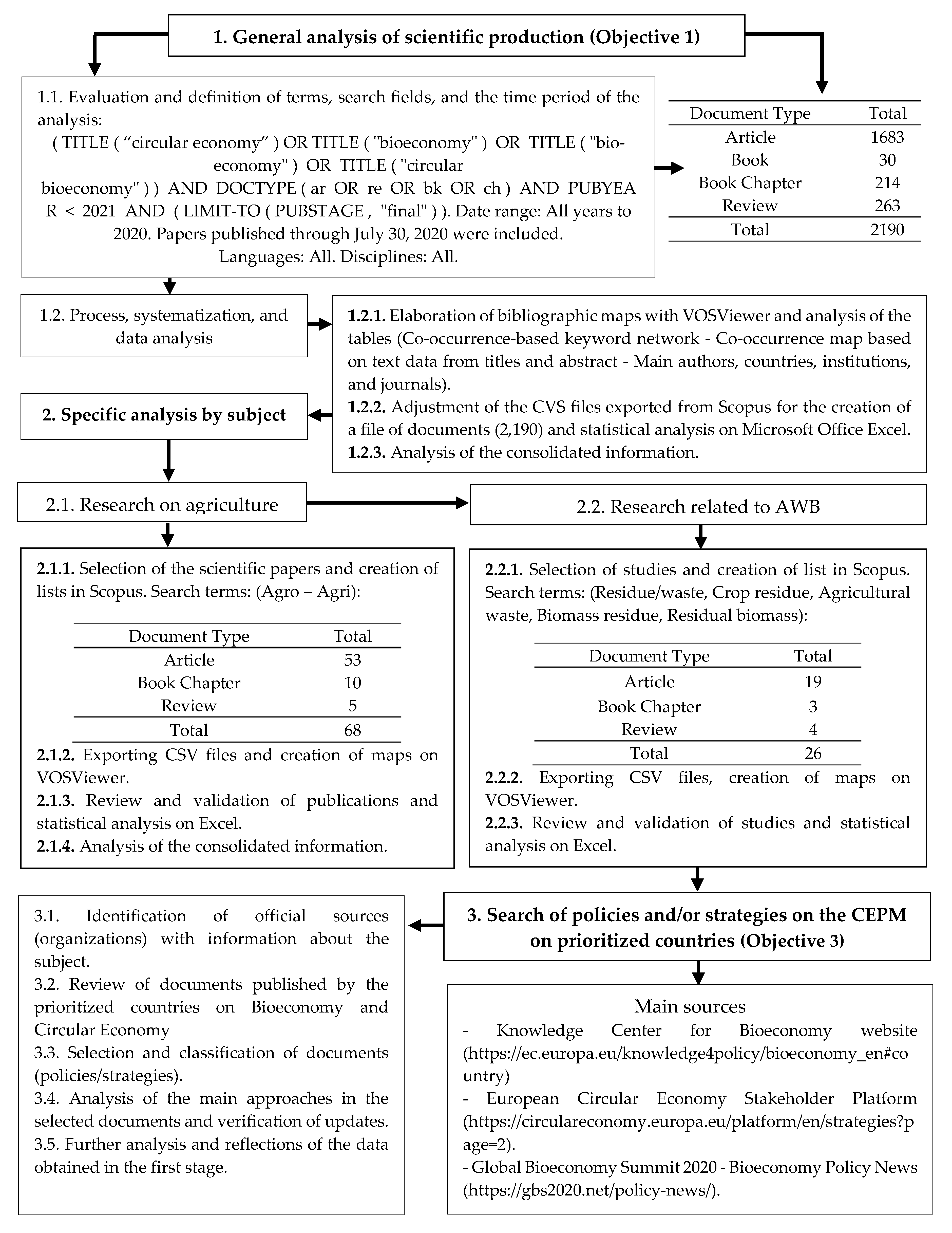
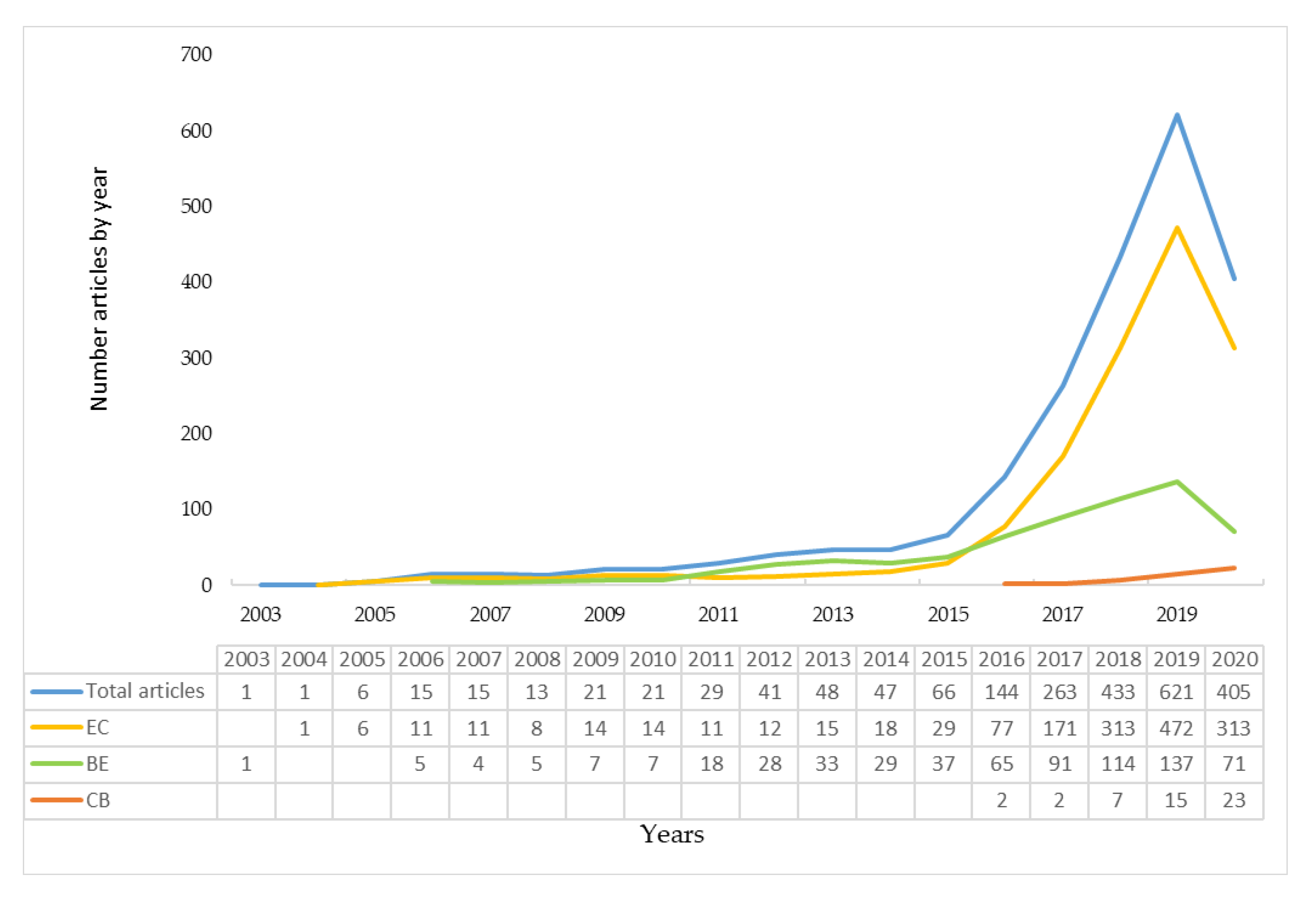
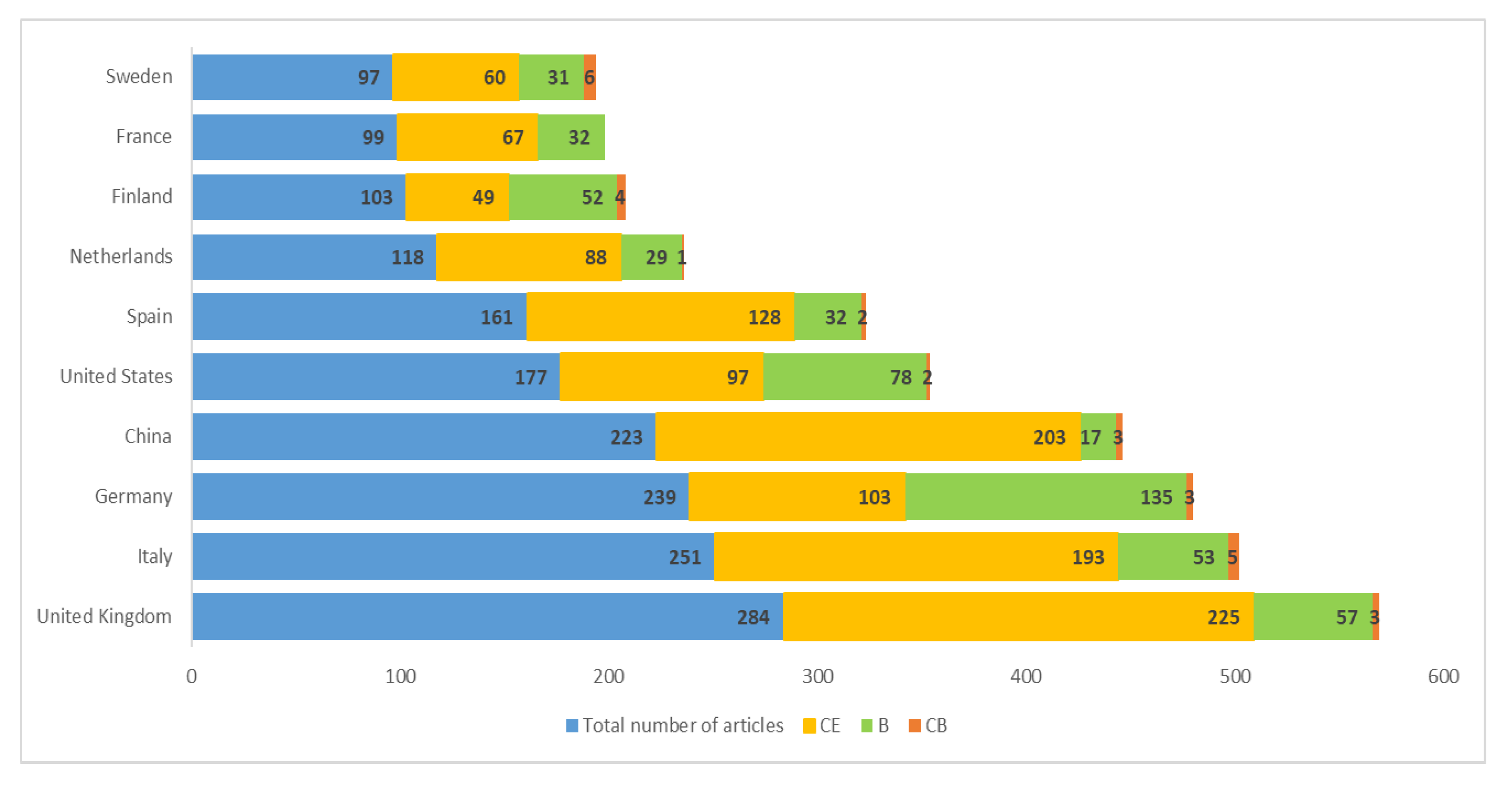
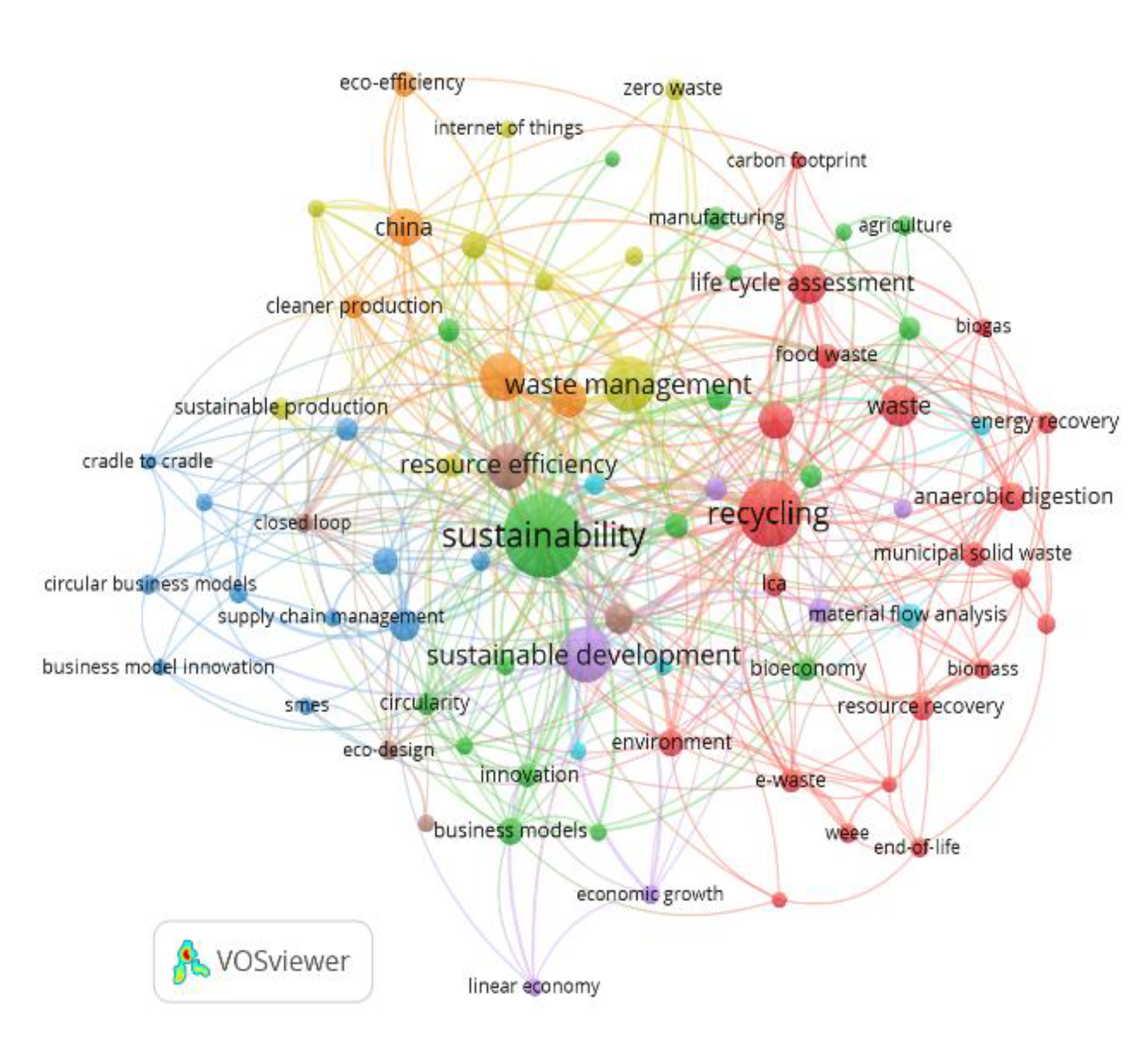
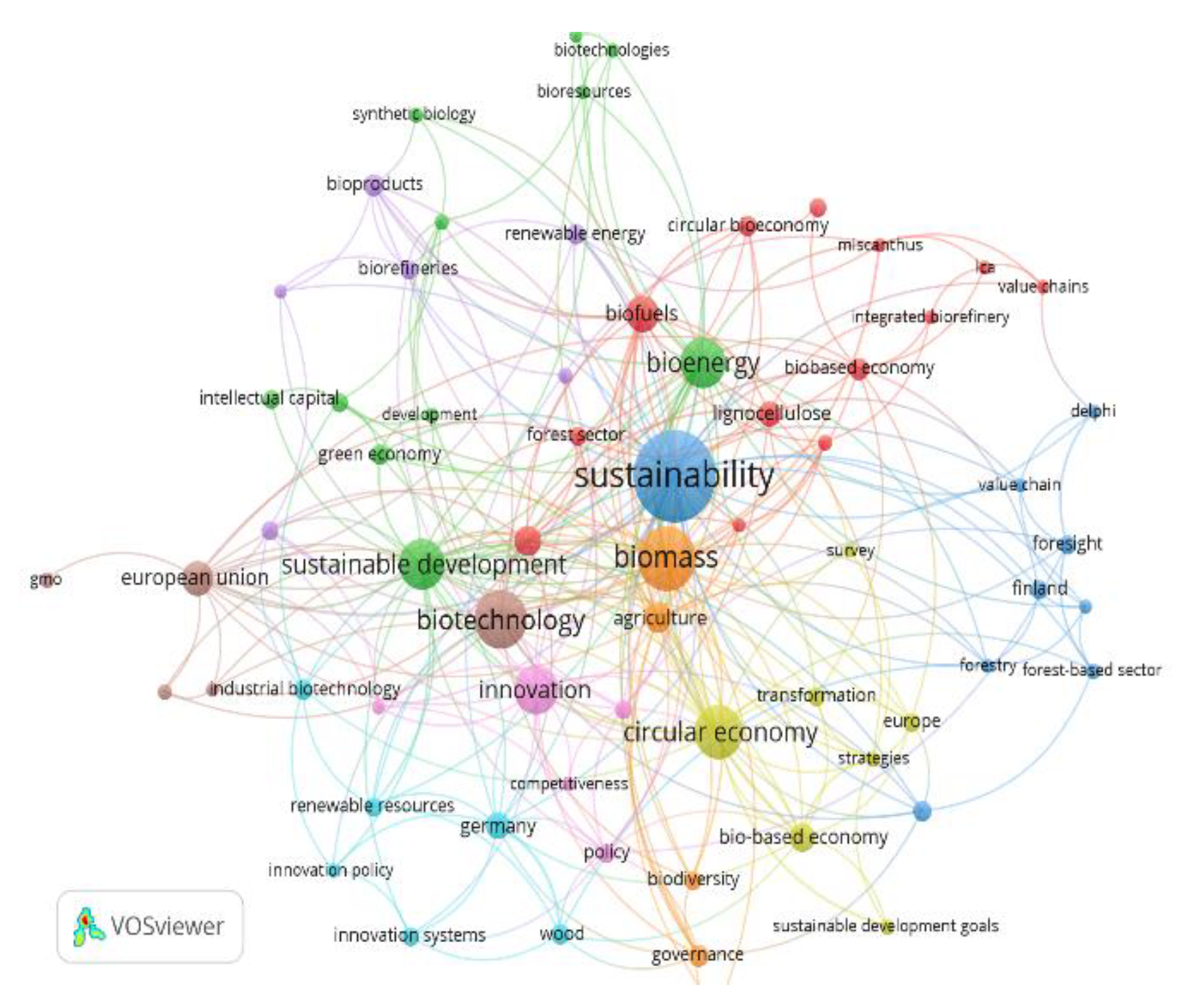
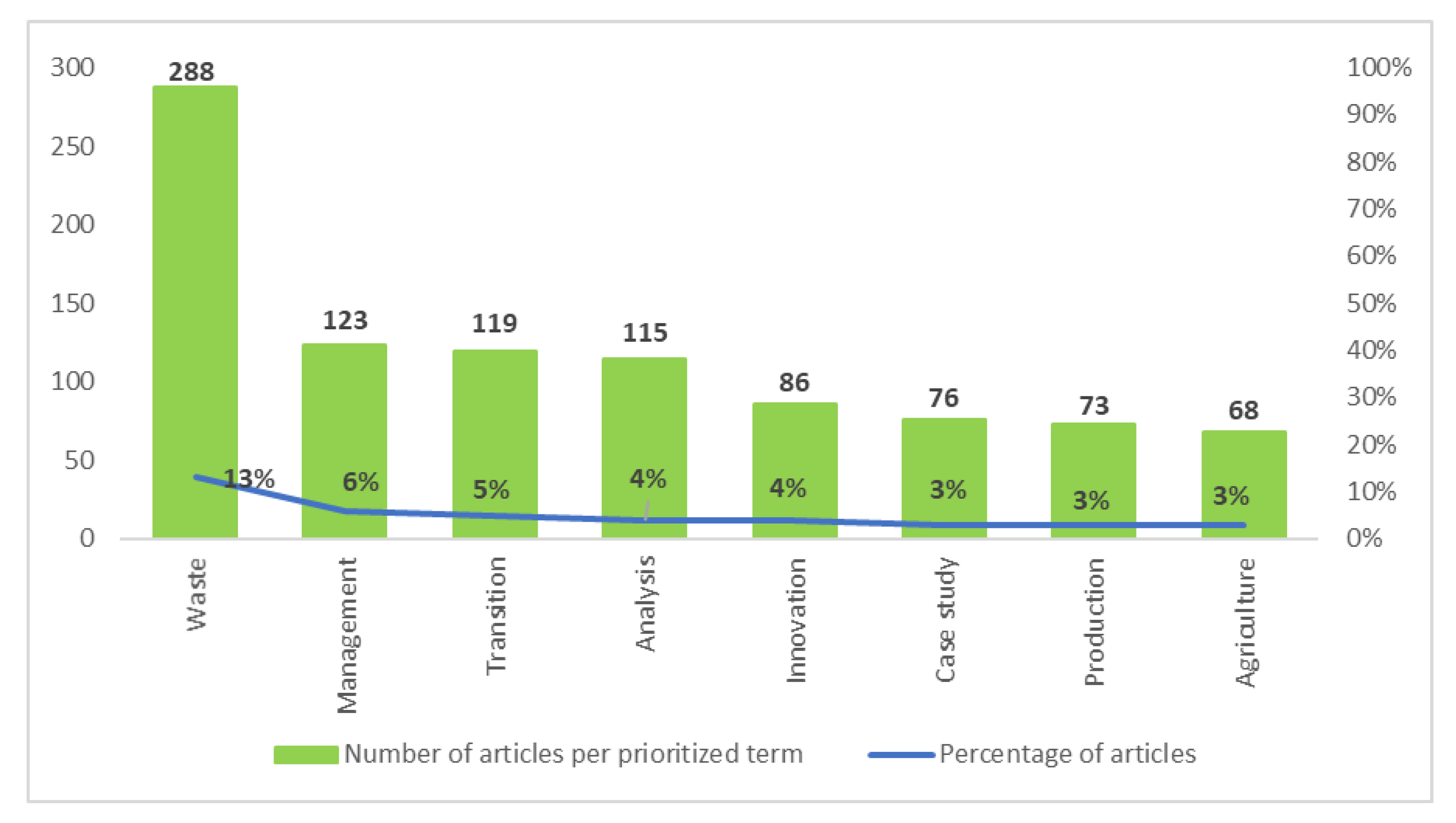
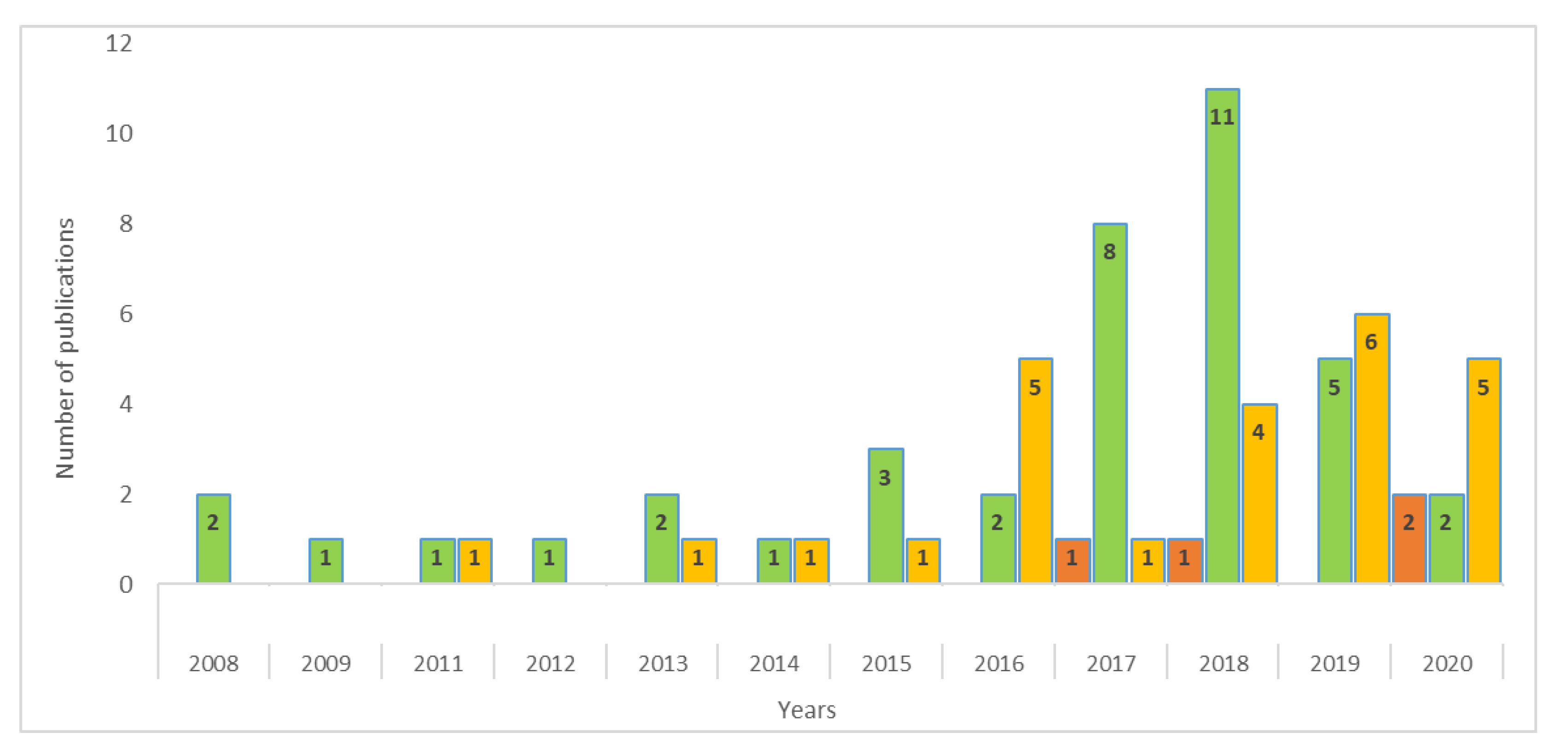
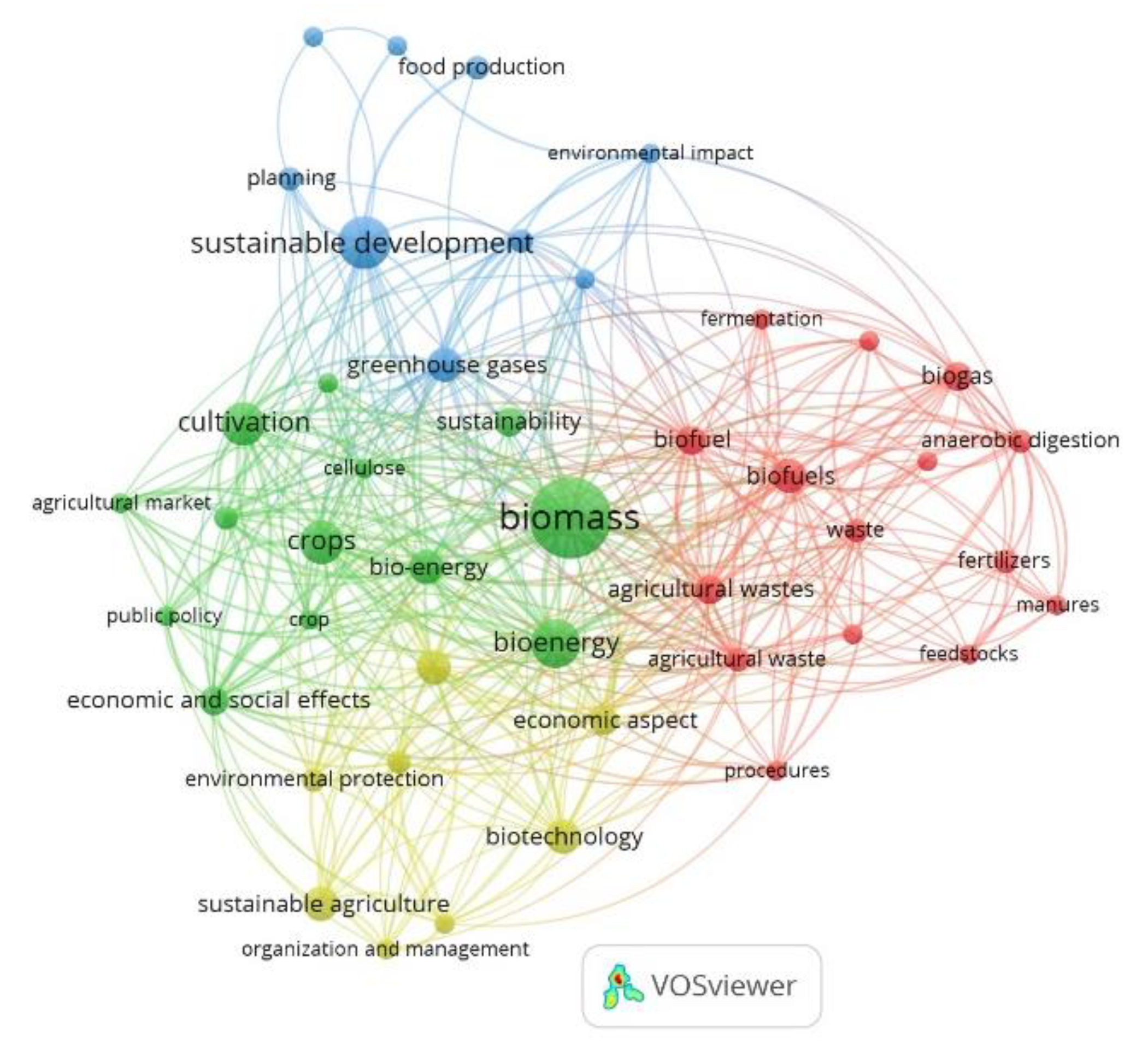
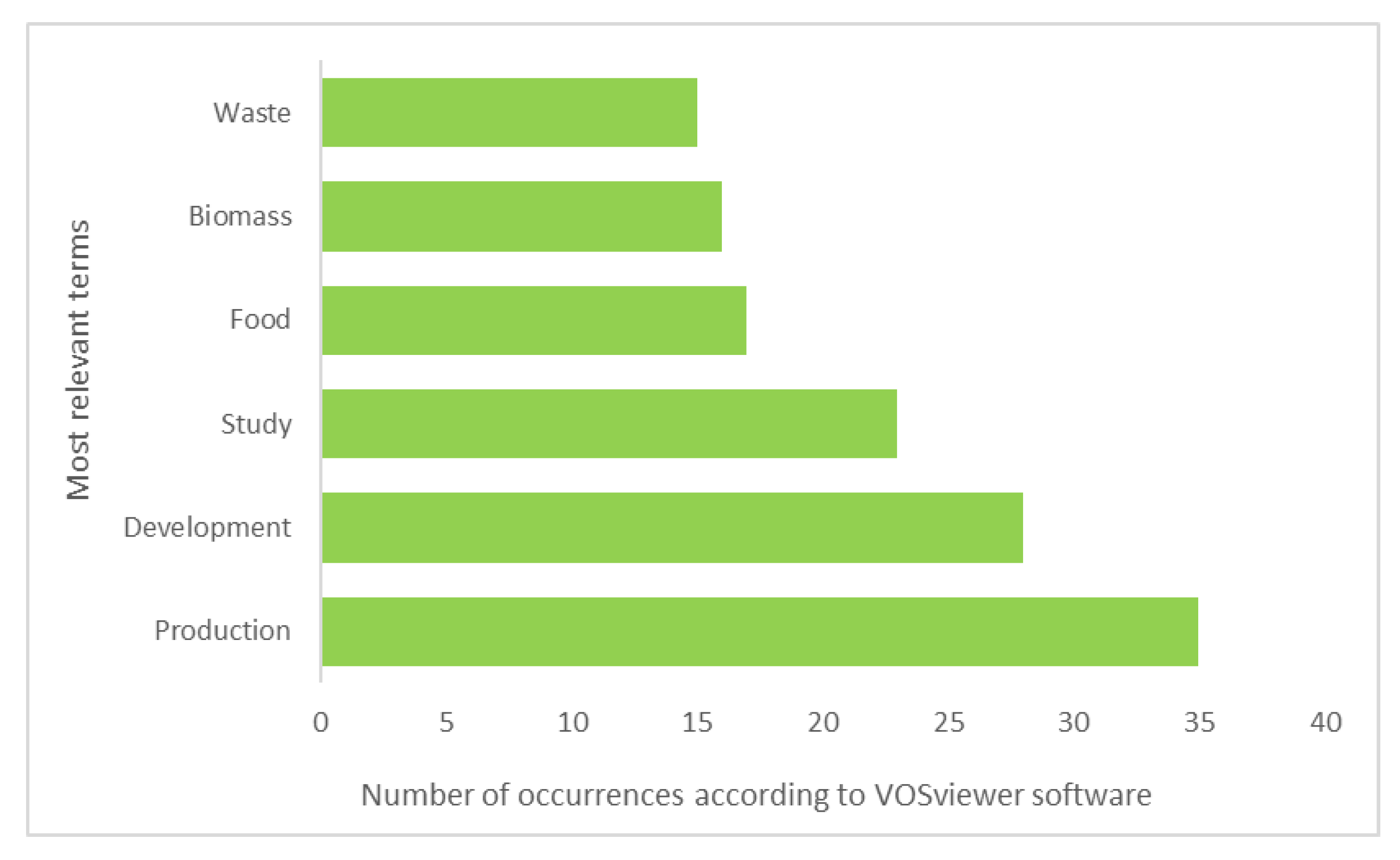
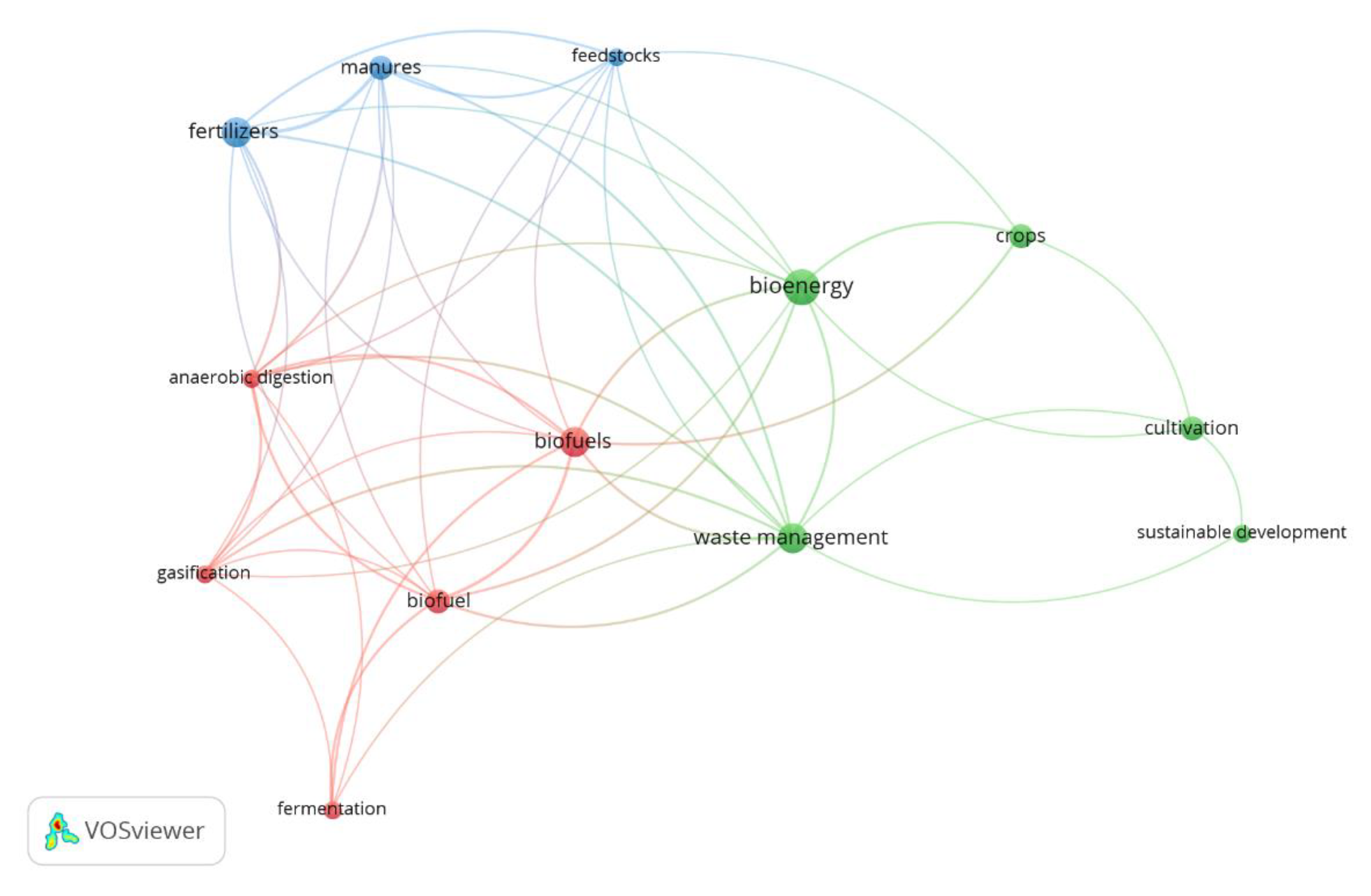
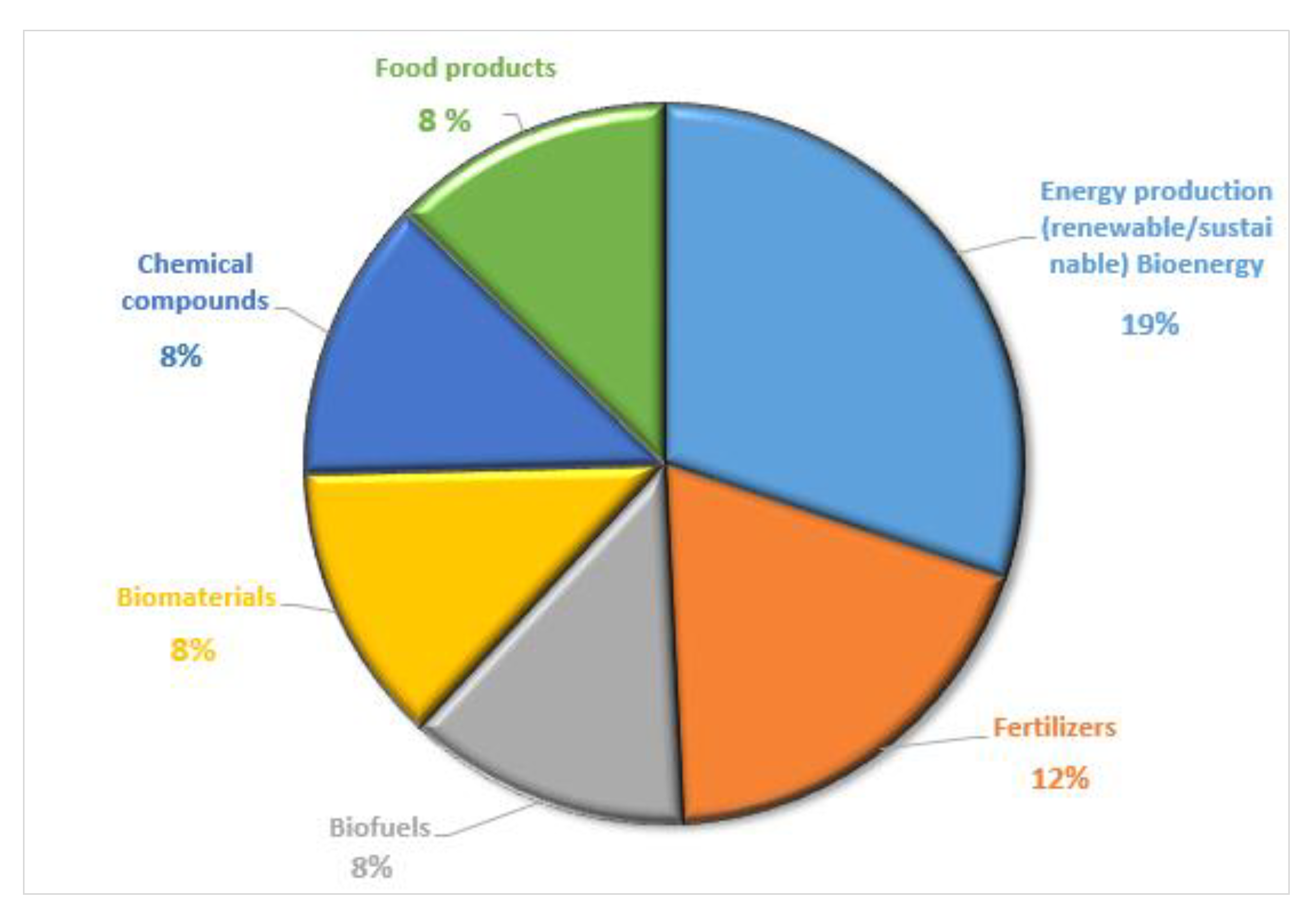
| Year | Name of the Study | Reference |
|---|---|---|
| 2017 | La producción científica española en el ámbito de la bioeconomía. 2005–2014 | [53] |
| 2017 | Scientific literature analysis on big data and internet of things applications on circular economy: a bibliometric study. | [54] |
| 2017 | Green, circular, bio economy: A comparative analysis of sustainability avenues | [5] |
| 2018 | Worldwide research on circular economy and environment: A bibliometric analysis. | [55] |
| 2018 | Bibliometric and review of the research on circular economy through the evolution of Chinese public policy. | [56] |
| 2018 | A definition of bioeconomy through the bibliometric networks of the scientific literature. | [57] |
| 2018 | Circular economy scientific knowledge in the European Union and China: A bibliometric, network and survey analysis (2006–2016). | [58] |
| 2020 | A literature review on forest bioeconomy with a bibliometric network analysis. | [59] |
| 2020 | Effects of Circular Economy Policies on the Environment and Sustainable Growth: Worldwide Research. | [60] |
| 2020 | The circular bioeconomy: Its elements and role in European bioeconomy clusters. | [33] |
| Document Type | % | Documents by CEPM | ||
|---|---|---|---|---|
| CE | BE | CB | ||
| Article | 77% | 1232 | 431 | 25 |
| Book | 1% | 10 | 20 | 0 |
| Book Chapter | 10% | 109 | 101 | 5 |
| Review | 12% | 145 | 100 | 19 |
| Total | 100% | 1496 | 652 | 49 |
| 68% | 30% | 2% | ||
| CEPM | A | AN | TC | Y | J | R |
|---|---|---|---|---|---|---|
| Circular Economy | A review on circular economy: The expected transition to a balanced interplay of environmental and economic systems | Ghisellini, P., Cialani, C., Ulgiati, S. | 990 | 2016 | Journal of Cleaner Production | [17] |
| The Circular Economy—A new sustainability paradigm? | Geissdoerfer, M., Savaget, P., Bocken, N.M.P., Hultink, E.J. | 794 | 2017 | Journal of Cleaner Production | [77] | |
| Product services for a resource-efficient and circular economy—A review | Tukker, A. | 586 | 2015 | Journal of Cleaner Production | [78] | |
| Conceptualizing the circular economy: An analysis of 114 definitions | Kirchherr, J., Reike, D., Hekkert, M. | 572 | 2017 | Resources, Conservation and Recycling | [79] | |
| Towards circular economy implementation: A comprehensive review in context of manufacturing industry | Lieder, M., Rashid, A. | 507 | 2016 | Journal of Cleaner Production | [80] | |
| Bioeconomy | The role of biomass and bioenergy in a future bioeconomy: Policies and facts | Scarlat, N., Dallemand, J.-F., Monforti-Ferrario, F., Nita, V. | 307 | 2015 | Environmental Development | [81] |
| The Bioeconomy in Europe: An Overview | McCormick, K., Kautto, N. | 263 | 2013 | Sustainability (Switzerland) | [82] | |
| Strategies and policies for the bioeconomy and bio-based economy: An analysis of official national approaches | Staffas, L., Gustavsson, M., McCormick, K. | 183 | 2013 | Sustainability (Switzerland) | [83] | |
| Limonene: A versatile chemical of the bioeconomy | Ciriminna, R., LomeliRodriguez, M., DemmaCarà, P., LopezSanchez, J.A., Pagliaro, M. | 160 | 2014 | Chemical Communications | [84] | |
| The Bioeconomy to 2030: Designing a policy agenda | Organisation for Economic Cooperation and Development (OECD) | 156 | 2009 | _ | [85] | |
| Circular Bioeconomy | Waste biorefinery models towards sustainable circular bioeconomy: Critical review and future perspectives | Venkata Mohan, S., Nikhil, G.N., Chiranjeevi, P., (...), Kumar, A.N., Sarkar, O. | 259 | 2016 | Bioresource Technology | [35] |
| Food waste biorefinery: Sustainable strategy for circular bioeconomy | Dahiya, S., Kumar, A.N., Shanthi Sravan, J., (...), Sarkar, O., Mohan, S.V. | 113 | 2018 | Bioresource Technology | [86] | |
| A Circular Bioeconomy with Biobased Products from CO2 Sequestration. | VenkataMohan, S., Modestra, J.A., Amulya, K., Butti, S.K., Velvizhi, G. | 99 | 2016 | Trends in Biotechnology | [34] | |
| A critical review of organic manure biorefinery models toward sustainable circular bioeconomy: Technological challenges, advancements, innovations, and future perspectives | Awasthi, M.K., Sarsaiya, S., Wainaina, S., (...), Jain, A., Taherzadeh, M.J. | 31 | 2019 | Renewable and Sustainable Energy Reviews | [87] | |
| Green Bioplastics as Part of a Circular Bioeconomy | Karan, H., Funk, C., Grabert, M., Oey, M., Hankamer, B. | 28 | 2019 | Trends in Plant Science | [88] |
| Autores | A | MEPC | TC | Institution | Country | 1st A | Last A | References | ||
|---|---|---|---|---|---|---|---|---|---|---|
| CE | BE | CB | ||||||||
| Birch, K | 13 | X | 566 | York University | Canada | 2009 | 2019 | [89,90,91] | ||
| Toppinen, A | 12 | X | X | 413 | Helsingin Yliopisto-Helsinki Institute of Sustainability Science | Finland | 2014 | 2020 | [95,96] | |
| Pagliaro, M | 12 | X | X* | 224 | Istituto Per Lo Studio Dei MaterialiNanostrutturati | Italy | 2014 | 2020 | [84,97] | |
| Zabaniotou, A | 12 | X | X | X | 200 | Aristotle University of Thessaloniki | Greece | 2015 | 2020 | [98,99] |
| Geng, Y | 11 | X | 1619 | China University of Mining and Technology | China | 2008 | 2018 | [92,93,94] | ||
| Bröring, S | 11 | X | 120 | Universität Bonn | Germany | 2015 | 2020 | [100,101] | ||
| Blumberga, D | 8 | X | X* | 5 | Riga Technical University | Latvia | 2019 | 2019 | [102,103] | |
| Charnley, F | 8 | X | 177 | University of Exeter | United Kingdom | 2017 | 2019 | [104,105] | ||
| Molina-Moreno, V | 8 | X | 182 | Universidad de Granada | Spain | 2016 | 2019 | [106,107] | ||
| Ciriminna, R | 8 | X | X * | 191 | Istituto Per Lo Studio Dei MaterialiNanostrutturati | Italy | 2014 | 2020 | [84,97] | |
| Country | % Articles | CEPM | CES | BE and/or CB | CE Strategy Name | BE Strategy Name | References | ||||
|---|---|---|---|---|---|---|---|---|---|---|---|
| CE | BE | CB | Yes | No | Yes | No | |||||
| United Kingdom | 15% | 79% | 20% | 1% | X | X | Making Things Last. A Circular Economy Strategy for Scotland (2016) London’s circular economy route map (2017) | Growing the Bioeconomy. Improving lives and strengthening our economy: A national bioeconomy strategy to 2030 (2018) | [109,110,111] | ||
| Italy | 13% | 77% | 21% | 2% | X | X | Towards a Model of Circular Economy for Italy Overview and Strategic Framework (2017) | BIT II Bioeconomy in Italy. A new bioeconomy strategy for a sustainable Italy (2019) | [112,113] | ||
| Germany | 12% | 43% | 56% | 1% | X | X | German Resource Efficiency Programme II Programme for the sustainable use and conservation of natural resources (2016) Pathways towards a German Circular Economy Lessons from European Strategies—Preliminary Study (2019) | Nationale Bioökonomiestrategie (2020) | [114,115,116,117] | ||
| China | 12% | 91% | 8% | 1% | X | Circular Economy Promotion Law of the People’s Republic of China (2009) The 13th Five-Year Plan for Economic and Social Development of the People’s Republic of China (2016–2020) (2016) | 13th FYP for Science, Technology and Innovation (2016). 13th FY Development Plan for Strategic Emerging Industries (2016) 13th FYP on Bioindustry Development (2016) | [29,56,118,119,120] | |||
| United States | 9% | 55% | 44% | 1% | X | - | The Bioeconomy Initiative: Implementing Framework (2019) | [29,121,122] | |||
| Spain | 8% | 80% | 20% | 1% | X | X | España Circular 2030. Circular Economy. Spanish Strategy (2020) | Spanish Bioeconomy Strategy: Horizon 2030 (2015). Estrategia Española de Bioeconomía. Horizonte 2030. Plan de actuación 2018. | [123,124,125] | ||
| Netherlands | 6% | 75% | 25% | 1% | X | X | A Circular Economy in the Netherlands by 2050 (2016) | The position of the bioeconomy in the Netherlands (2018) | [126,127] | ||
| Finland | 5% | 48% | 50% | 4% | X | X | Leading the cycle. Finnish road map to a circular economy 2016–2025 (2016) | The Finnish Bioeconomy Strategy (2014) | [128,129] | ||
| France | 5% | 68% | 32% | 0% | X | X | The anti-waste law in the daily lives of the French people, what does that mean in practice? Anti-waste law for a circular economy (2020) | A Bioeconomy Strategy for France (2017). A Bioeconomy Strategy for France 2018–2020 Action Plan (2018) | [130,131,132] | ||
| Sweden | 5% | 62% | 32% | 6% | X | X | Resource Effectiveness and the Circular Economy (2020) | Swedish Research and Innovation Strategy for a Bio-based Economy (2012) | [133,134] | ||
| Total | 91% | 69% | 29% | 2% | |||||||
| Institution | A | % | CEPM | C | IT | (TC) [Reference] | |||
|---|---|---|---|---|---|---|---|---|---|
| CE | BE | CB | U | PRC | |||||
| Bucharest University of Economic Studies | 34 | 2% | 23 | 11 | 0 | Romania | X | (116) [146] | |
| Delft University of Technology | 29 | 1% | 26 | 3 | 0 | Netherlands | X | (2019) [77] | |
| Lunds Universitet | 29 | 1% | 16 | 11 | 2 | Sweden | X | (1161) [82] | |
| Università degli Studi di Catania | 28 | 1% | 20 | 8 | 0 | Italy | X | (184) [147] | |
| Universität Hohenheim | 26 | 1% | 0 | 26 | 0 | Germany | X | (376) [147] | |
| Wageningen University & Research | 25 | 1% | 8 | 17 | 0 | Netherlands | X | (459) [148] | |
| European Commission Joint Research Centre | 25 | 1% | 7 | 18 | 0 | Belgium | X | (725) [81] | |
| Chinese Academy of Sciences | 22 | 1% | 21 | 0 | 1 | China | X | (1626) [93] | |
| Consiglio Nazionale delle Ricerche | 21 | 1% | 9 | 11 | 1 | Italy | X | (250) [84] | |
| The University of Manchester | 20 | 1% | 20 | 0 | 0 | United Kingdom | X | (311) [149] | |
| Total | 259 | 12% | 150 (58%) | 105 (41%) | 4 (2%) | ||||
| Journal | A | CEPM | Journal H index | SJR | C | (TC) [Reference] | ||
|---|---|---|---|---|---|---|---|---|
| CE | BE | CB | ||||||
| Journal of Cleaner Production | 222 | 186 | 34 | 3 | 173 | 1.886(Q1) | Netherlands | (9650) [17] |
| Sustainability | 187 | 132 | 54 | 1 | 68 | 0.58 (Q2) | Switzerland | (2946) [151] |
| Resources Conservation and Recycling | 87 | 87 | 0 | 0 | 119 | 2.22 (Q1) | Netherlands | (2728) [79] |
| Amfiteatru Economic | 35 | 12 | 23 | 0 | 18 | 0.28 (Q2) | Romania | (81) [146] |
| Bioresource Technology | 32 | 15 | 3 | 14 | 273 | 2.43 (Q1) | Netherlands | (915) [35] |
| Journal of Industrial Ecology | 30 | 29 | 1 | 0 | 95 | 1.81 (Q1) | United States | (1949) [153] |
| Waste Management | 25 | 25 | 0 | 0 | 145 | 1.63 (Q1) | United Kingdom | (390) [154] |
| Science of the Total Environment | 25 | 22 | 2 | 1 | 224 | 1.66 (Q1) | Netherlands | (248) [155] |
| Industrial Biotechnology | 22 | 2 | 19 | 1 | 30 | 0.31 (Q3) | United States | (129) [156] |
| Biofuels Bioproducts and Biorefining | 22 | 1 | 20 | 1 | 78 | 1.14 (Q1) | United Kingdom | (223) [157] |
| Total | 687 | 511 | 156 | 21 | ||||
| 31% | 74% | 23% | 3% | |||||
| Sustainability | Recycling | Sustainable Development | Waste Management | Industrial Ecology |
|---|---|---|---|---|
| 223 (10%) | 107 (5%) | 91 (4%) | 69 (3%) | 55 (3%) |
| Resource efficiency | Life cycle assessment | Waste | Bioenergy | China |
| 48 (2%) | 43 (2%) | 39 (2%) | 38 (2%) | 35 (2%) |
| Innovation | Industrial symbiosis | Reuse | Biotechnology | Biomass |
| 32 (1%) | 31 (1%) | 31 (1%) | 31 (1%) | 29 (1%) |
| Environment | Remanufacturing | European Union | Renewable energy | Agriculture |
| 20 (1%) | 20 (1%) | 19 (1%) | 19 (1%) | 18 (1%) |
| Year | Document title | TC | CEPM | R | Year | Document title | TC | CEPM | Reference | ||
|---|---|---|---|---|---|---|---|---|---|---|---|
| CE | BE | CE | BE | ||||||||
| 2013 | Divergent Paradigms of European Agro-Food Innovation: The Knowledge-Based Bio-Economy (KBBE) as an R&D Agenda | 87 | X | [165] | 2015 | Boosting circular economy and closing the loop in agriculture: Case study of a small-scale pyrolysis-biochar based system integrated in an olive farm in symbiosis with an olive mill. | 30 | X | [98] | ||
| 2012 | EU agri-innovation policy: Two contending visions of the bio-economy | 69 | X | [166] | 2019 | Contribution to Circular Economy options of mixed agricultural wastes management: Coupling anaerobic digestion with Gasification for enhanced energy and material recovery. | 27 | X | [45] | ||
| 2009 | From the petro-economy to the bioeconomy: Integrating bioenergy production with agricultural demands | 33 | X | [167] | 2013 | Twenty-first century bioeconomy: Global challenges of biological knowledge for health and agriculture. | 24 | X | [168] | ||
| 2017 | Design of marine macroalgae photobioreactor integrated into building to support seagriculture for biorefinery and bioeconomy. | 30 | X | [169] | 2016 | The seven challenges for transitioning into a bio-based circular economy in the agri-food sector. | 19 | X | [170] | ||
| 2016 | Towards a Circular Economy in Australian Agri-food Industry: An Application of Input-Output Oriented Approaches for Analyzing Resource Efficiency and Competitiveness Potential | 30 | X | [171] | 2018 | An efficient agro-industrial complex in Almería (Spain): Towards an integrated and sustainable bioeconomy model. | 15 | X | [172] | ||
| Title | Year | CEPM | Reference | Title | Year | CEPM | Reference | ||
|---|---|---|---|---|---|---|---|---|---|
| CE | BE/CB | CE | BE/CB | ||||||
| A novel compost for rice cultivation developed by rice industrial by-products to serve circular economy | 2019 | X | [174] | Promoting Circular Economy Through Sustainable Agriculture in Hidalgo: Recycling of Agro-Industrial Waste for Production of High Nutritional Native Mushrooms | 2019 | X | [48] | ||
| A spatial approach to bioeconomy: Quantifying the residual biomass potential in the EU-27 | 2019 | X | [43] | Refining biomass residues for sustainable energy and bio-products: An assessment of technology, its importance, and strategic applications in circular bio-economy | 2020 | X | [37] | ||
| Agriculture waste valorisation as a source of antioxidant phenolic compounds within a circular and sustainable bioeconomy | 2020 | X | [47] | Role of biogenic waste and residues as an important building block towards a successful energy transition and future bioeconomy–Results of a site analysis | 2020 | X | [31] | ||
| Are Primary Agricultural Residues Promising Feedstock for the European Bioeconomy? | 2017 | X | [15] | Sugarcane: A potential agricultural crop for bioeconomy through biorefinery | 2017 | X | [13] | ||
| Assessment of agroforestry residue potentials for the bioeconomy in the European Union | 2018 | X | [46] | Ten-year legacy of organic carbon in non-agricultural (brownfield) soils restored using green waste compost exceeds 4 per mille per annum: Benefits and trade-offs of a circular economy approach | 2019 | X | [175] | ||
| Bioeconomy and the production of novel food products from agro-industrial wastes and residues under the context of food neophobia | 2018 | X | [176] | The bioeconomy of microalgal heterotrophic bioreactors applied to agroindustrial wastewater treatment | 2017 | X | [177] | ||
| Camelina and crambe oil crops for bioeconomy-straw utilisation for energy | 2020 | X | [178] | The circular economy of agro and post-consumer residues as raw materials for sustainable ceramics | 2020 | X | [50] | ||
| Cellulolytic enzyme production from agricultural residues for biofuel purpose on circular economy approach | 2019 | X | [179] | The management of agricultural waste biomass in the framework of circular economy and bioeconomy: An opportunity for greenhouse agriculture in Southeast Spain | 2020 | X | X | [7] | |
| Co-digestion of by-products and agricultural residues: A bioeconomy perspective for a Mediterranean feedstock mixture | 2020 | X | [180] | The potential of plantain residues for the Ghanaian bioeconomy-assessing the current fiber value web | 2018 | X | [181] | ||
| Contribution to Circular Economy options of mixed agricultural waste management: Coupling anaerobic digestion with gasification for enhanced energy and material recovery | 2019 | X | [45] | Tomato’s Green Gold: Bioeconomy Potential of Residual Tomato Leaf Biomass as a Novel Source for the Secondary Metabolite Rutin | 2019 | X | [182] | ||
| Fruit waste streams in South Africa and their potential role in developing a bio-economy | 2015 | X | [173] | Towards circular economy solutions for the management of rice processing residues to bioenergy via gasification | 2019 | X | [44] | ||
| Intermediate pyrolysis of agricultural waste: A decentral approach towards circular economy | 2018 | X | [183] | Valorising agro-industrial wastes within the circular bioeconomy concept: The case of defatted rice bran with emphasis on bioconversion strategies | 2020 | X | [184] | ||
| Planning the Flows of Residual Biomass Produced by Wineries for Their Valorization in the Framework of a Circular Bioeconomy | 2020 | X | [185] | Valorization of agricultural waste for biogas-based circular economy in India: A research outlook | 2020 | X | [186] | ||
Publisher’s Note: MDPI stays neutral with regard to jurisdictional claims in published maps and institutional affiliations. |
© 2020 by the authors. Licensee MDPI, Basel, Switzerland. This article is an open access article distributed under the terms and conditions of the Creative Commons Attribution (CC BY) license (http://creativecommons.org/licenses/by/4.0/).
Share and Cite
Duque-Acevedo, M.; Belmonte-Ureña, L.J.; Yakovleva, N.; Camacho-Ferre, F. Analysis of the Circular Economic Production Models and Their Approach in Agriculture and Agricultural Waste Biomass Management. Int. J. Environ. Res. Public Health 2020, 17, 9549. https://doi.org/10.3390/ijerph17249549
Duque-Acevedo M, Belmonte-Ureña LJ, Yakovleva N, Camacho-Ferre F. Analysis of the Circular Economic Production Models and Their Approach in Agriculture and Agricultural Waste Biomass Management. International Journal of Environmental Research and Public Health. 2020; 17(24):9549. https://doi.org/10.3390/ijerph17249549
Chicago/Turabian StyleDuque-Acevedo, Mónica, Luis Jesús Belmonte-Ureña, Natalia Yakovleva, and Francisco Camacho-Ferre. 2020. "Analysis of the Circular Economic Production Models and Their Approach in Agriculture and Agricultural Waste Biomass Management" International Journal of Environmental Research and Public Health 17, no. 24: 9549. https://doi.org/10.3390/ijerph17249549
APA StyleDuque-Acevedo, M., Belmonte-Ureña, L. J., Yakovleva, N., & Camacho-Ferre, F. (2020). Analysis of the Circular Economic Production Models and Their Approach in Agriculture and Agricultural Waste Biomass Management. International Journal of Environmental Research and Public Health, 17(24), 9549. https://doi.org/10.3390/ijerph17249549








